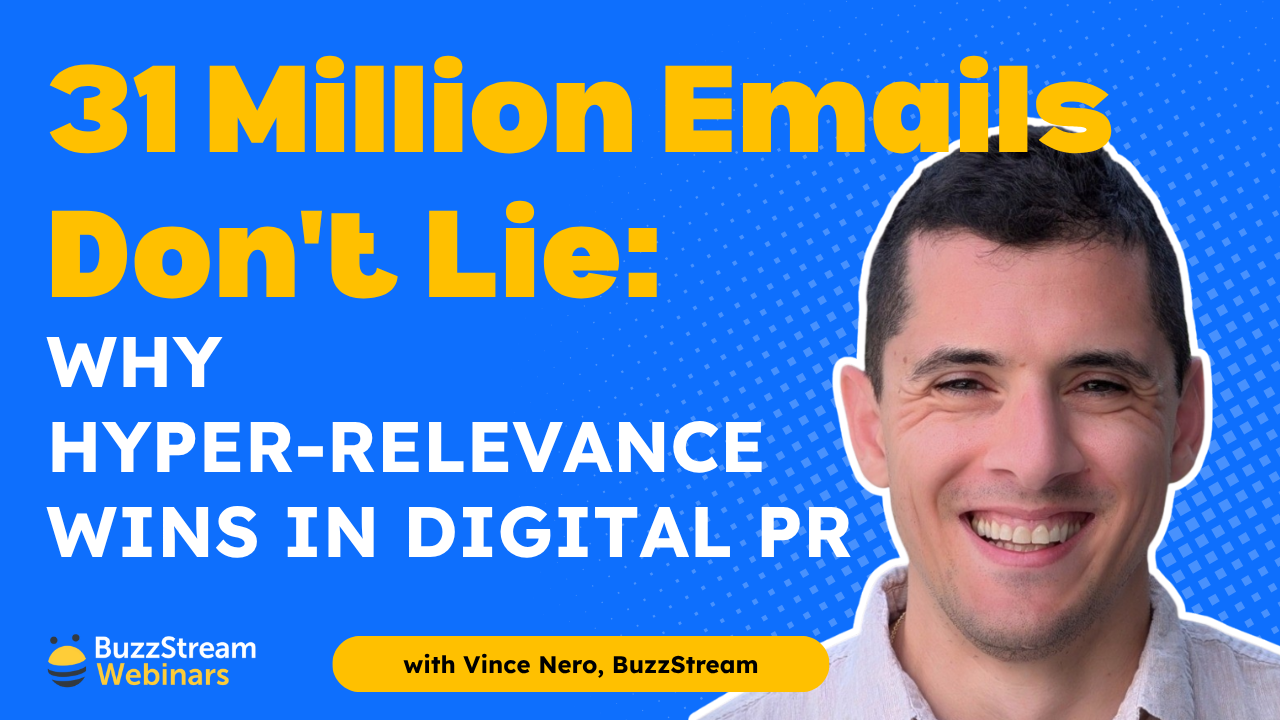Table of Contents
- Keyword-driven digital PR blends SEO goals with pitchable assets for both top- and bottom-funnel impact.
- Interactive tools and quizzes earn high-authority links while targeting transactional search intent.
- Visual-led content—especially unique data visualizations—drives broad media coverage and passive link growth.
- Proprietary, survey, or scraped data studies power high-performing evergreen and recurring digital PR campaigns.
- Regional studies and newsjacking tactics generate localized press coverage and real-time media buzz.
- AI image generation and trendspotting tools (e.g., Midjourney, Exploding Topics) enhance ideation and outreach.
The term digital PR means different things depending on who you ask.
We even had an entire podcast episode devoted to the differences between digital PR strategies US and UK with Rise at Seven’s Will Hobson. We’ve also discussed the differences between digital PR and traditional.
Some people refer to digital PR as content-led link building, but there is a lot more to it. There are also asset-less digital PR strategies that include pitching quotes to journalists.
Ultimately, digital PR is designed to build high-authority links to help you build your brand and rank better.
Instead of showing you digital PR examples by industry, I’ve broken it down into different ideation strategies and vehicles that drive the content.
Since most people reading this are interested in ideas for their brands or clients, I will avoid showcasing publications like NYTimes, Pudding, or VisualCapitalist, as well as independent artists and content creators like Neal Agarwal or others you might find on r/dataisbeautiful.
Those are all great examples of content that gets links and coverage, but they aren’t as helpful if you want to replicate them as a brand.
So, without further ado, here are some of the best digital PR examples that work today.
Keyword-Driven Digital PR
Strategically tying keywords to digital PR campaigns has many benefits. I actually wrote a whole post about tying search volume to a digital PR survey-type campaign.
- If you can tie search volume to your digital PR campaigns, you can get extra value out of the links that you build, which is outlined in my digital PR for SEO post.
- Alternatively, you may need a little boost for some lower to mid-authority sites to get ranking. I refer to this as “jump-start link building.”
- Lastly, bigger brands that don’t necessarily need many links to rank can rank more quickly with a little link building.
Building links to a product, service, or “money” page can be challenging. Many brands utilize digital PR to drive links to an asset and then use internal linking to direct SEO or link value to their money page. (More on this in a bit.)
You have to go further up the funnel to find relevant keywords for your brand while still maintaining pitchability.
So, let’s take a look at a couple of examples.
1. Most Affordable Cities to Buy a House from Homebuyer.com
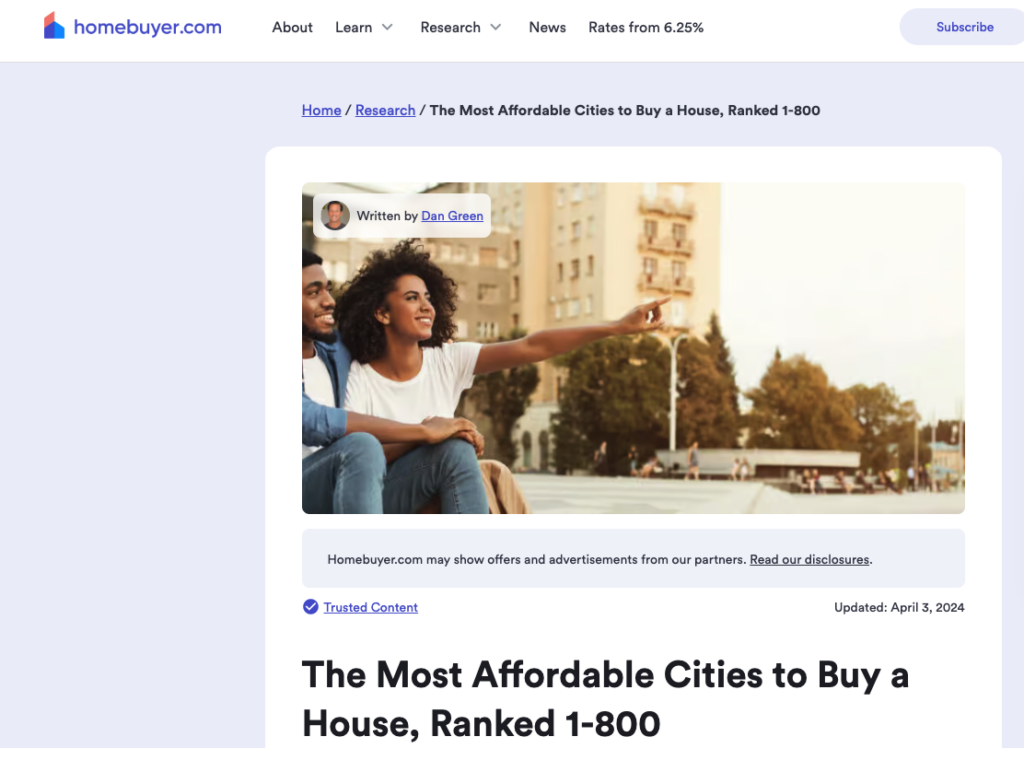
Strategy: Building a pitchable city “index” study around a mid-funnel keyword.
Homebuyer.com is a lender for first-time home buyers. When I worked for them, I helped create a post around the cheapest cities to buy a home.
To create the index (as some call it), I weighted a handful of criteria, such as homeowners insurance and transportation costs, and then assigned scores for over 800 cities.
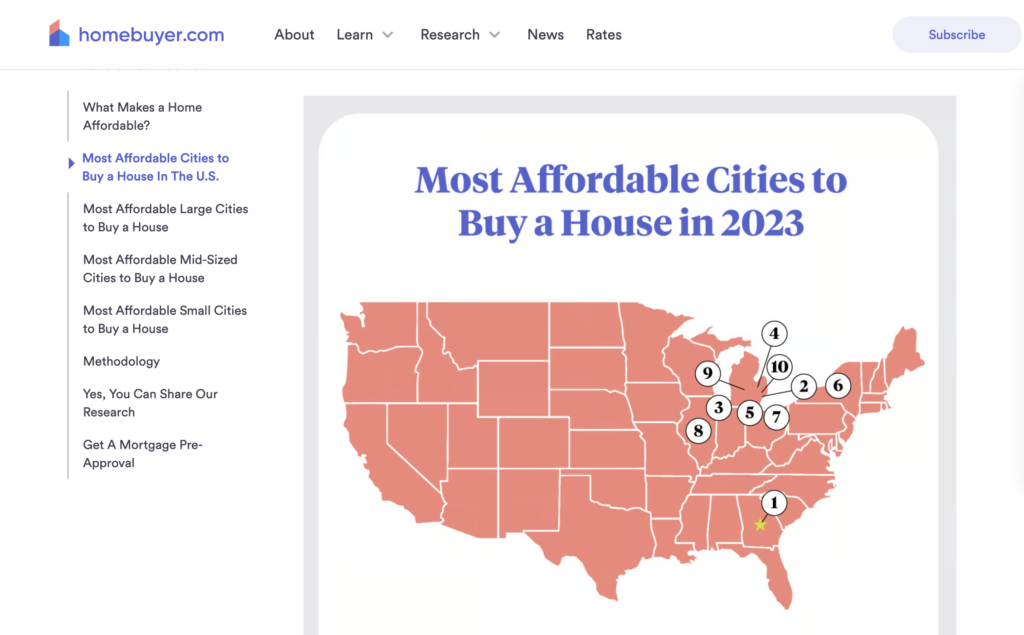
Then, I divided the post into four sections: an overall list of affordable cities and a list of affordable large, medium, and small cities.
How to pitch: This gave me four rankings lists that I could pitch to journalists in the local media outlets in the top-ranking cities.
But since it’s a nationwide study, I knew national pubs would be interested.
Results: While the search term “cheapest cities to buy a house” isn’t likely to lead users to buy directly, it has a traffic potential of 3.6k monthly searches. They rank #5, and it has bought in over 80 LRD (Linking root domains, aka backlinks from unique sites.)
Coverage came from high-authority media like Yahoo, Lifehacker, and local news sites for top-ranking cities like Chicago and Cleveland.
Whereas the primary goal of this Homebuyer.com post was to raise awareness of the top-mid funnel, it is possible to achieve a lower funnel.
Next are two examples of search-driven keywords related to tools that are pitchable for coverage and can serve as bottom-funnel lead generators for companies.
2. Pinrose’s Fragrance Quiz
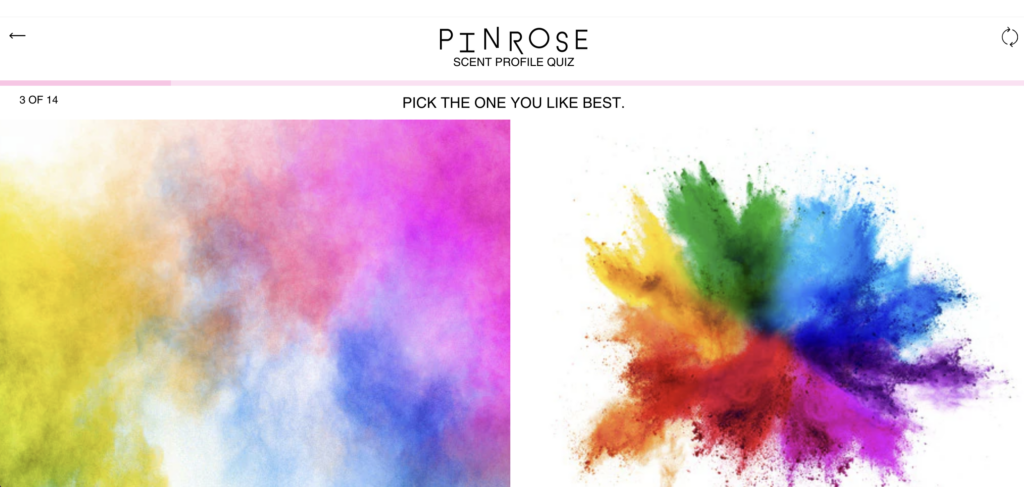
Strategy: Building a pitchable interactive tool that serves as a bottom-funnel, keyword-driven asset.
Pinrose is a fragrance company that sells candles, perfumes, and lotions. Using the “science of synesthesia,” they created a tool to help you choose a scent that works for you.
By the end of the 9-question quiz, Pinrose presents you with recommendations to buy.
How to pitch: This approach gives Pinrose an asset when pitching to beauty and lifestyle journalists. These journalists talk about topics like fragrances, and since their readers would also value a quiz like this, it makes it much easier to pitch.
They also gain links for a relevant keyword by tying this to search volume.

Results: You can see coverage from lifestyle publishers like Self and TeenVogue, aligning with Pinrose’s buyer persona.
Then, because of their link building, the asset ranks for the keyword “perfume quiz,” which brings in 2.3K monthly searches. This traffic is highly relevant and much further down the funnel.
Interactive tools like this are a tremendous way to build quality links via a digital PR asset. Because they are shareable and tied to search volume, they can even grow links passively—more on that approach next.
3. Hubspot Marketing Statistics
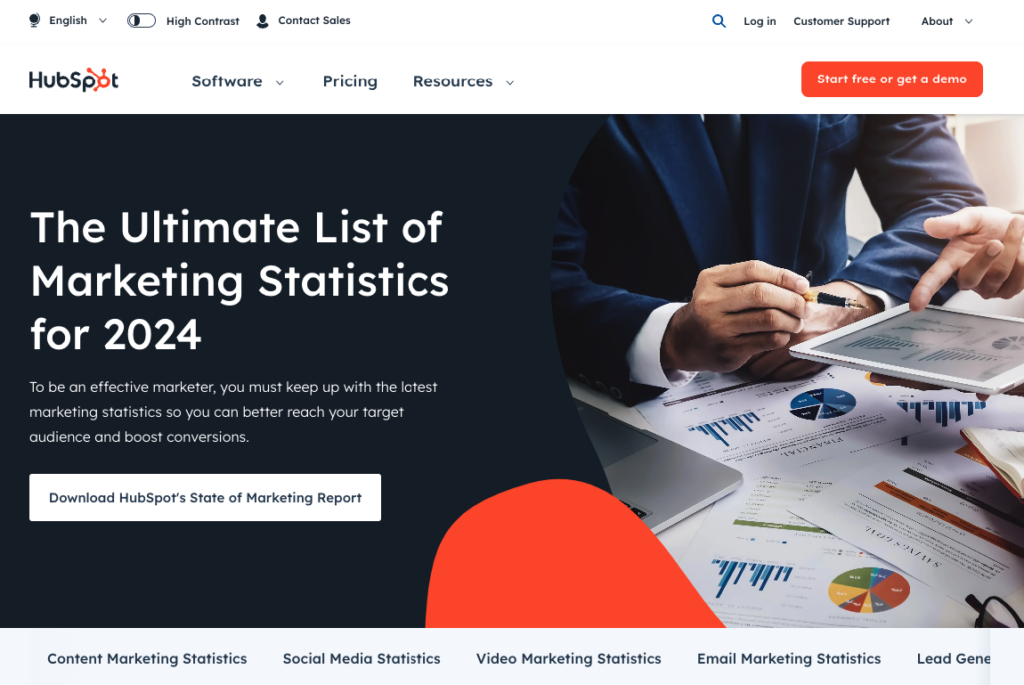
Strategy: Gathering proprietary data to make a pitchable search-driven post (with high link intent).
You can grow links passively by targeting a keyword with high link intent. This is where some of the digital PR lines get a bit blurry because these topics can be harder to pitch.
However, if you can find the right topic, you can have great success growing links over time.
Statistics posts are some of the most common examples of this. These are keyword phrases that writers search for when researching an article.
To create these posts, you can gather statistics from the web (most people do this) or utilize your proprietary data (which is much more effective in the long run). If it’s interesting, you can pitch it for coverage.
Let’s look at how Hubspot does this with their Marketing Statistics post.
They’ve compiled their statistics into a post with research, breaking it down into categories like content marketing statistics and social media, as well as subcategories like blogging or content strategy.
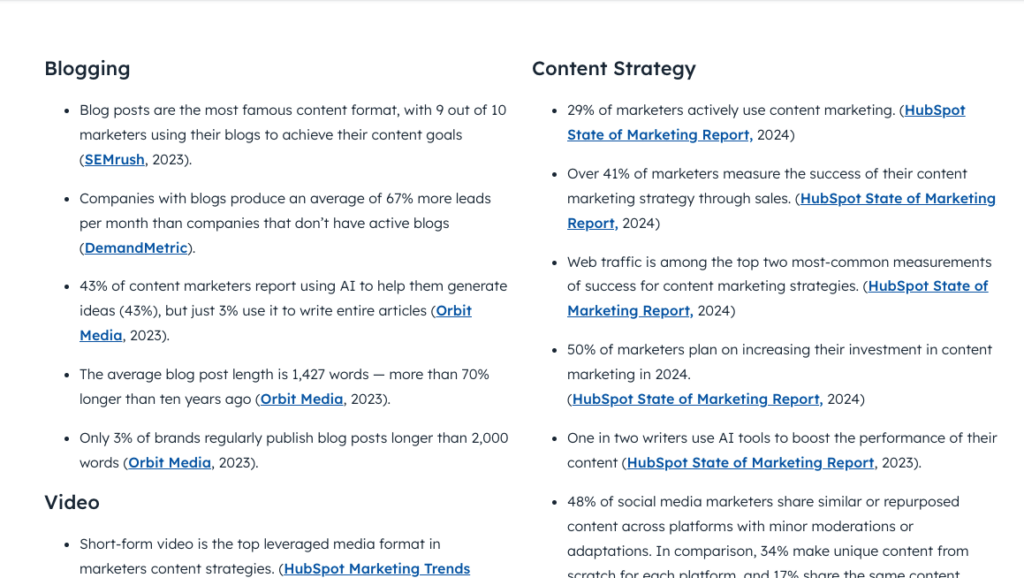
How to pitch: They not only have the statistics (most of which are proprietary data), but they’ve also collected everything into one massive report. This report becomes a shareable asset, and they can pitch to get links from high-authority marketing industry sites.
It also becomes information that anyone discussing marketing may want to cite passively.
Results: The coverage shows that they achieved both. They’ve got links from highly authoritative industry sites like Inc.com, Huffington Post, Entrepreneur, and CBS News, as well as marketing sites like Shopify and Salesforce.
They refresh the statistics yearly, so their link profile has climbed to almost 14,000 Linking Root Domains (LRD).
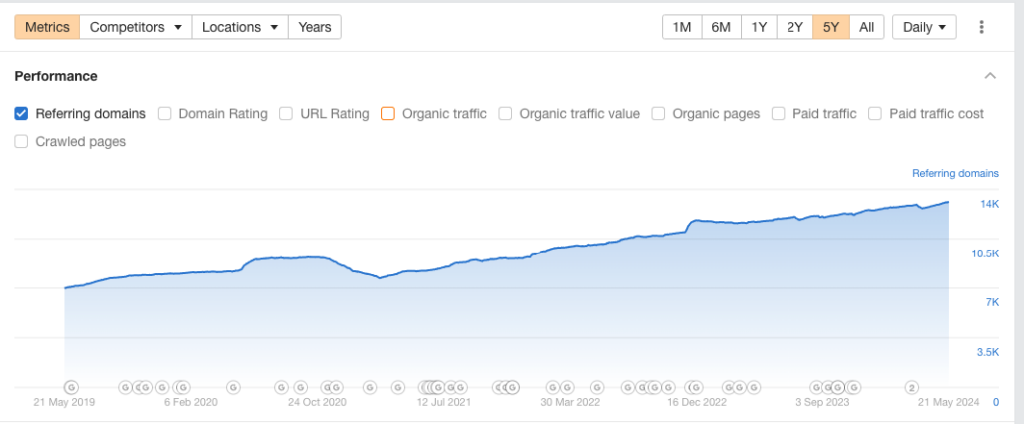
Tip: AI Overview may help this approach even more. Google shows statistics and cites sources. (However, the ones I see don’t always cite the original source.)
But statistics are the only way to gain passive links. Let’s look at another keyword-driven post.
4. Casper’s Couples Sleeping Positions
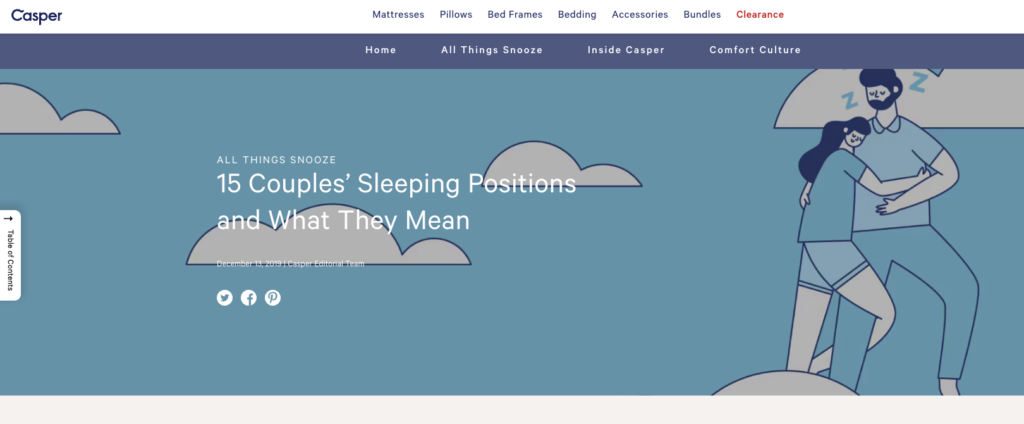
Strategy: Using survey data to make a (non-passive link intent) keyword-driven post pitchable.
In a Casper post I worked on, we chose a keyword—couples sleeping positions—and built a blog post around it.
But, to jump-start it, we also gathered some proprietary data.
Why?
So that we could make this more enticing to pitch.
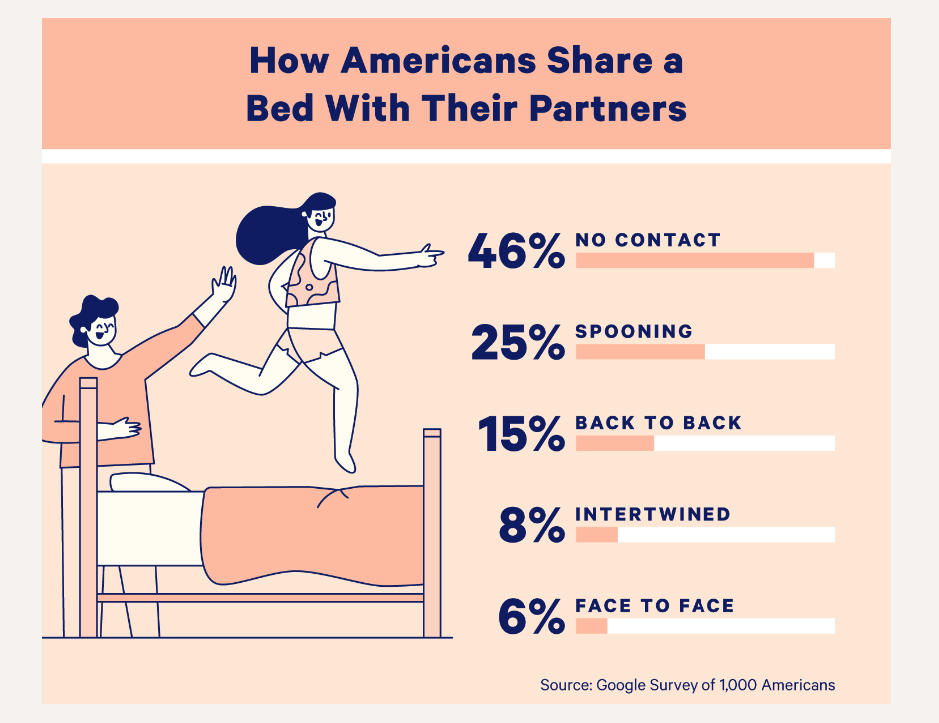
How to pitch: With a shareable asset with brand new data, we could pitch to high-authority sites to discuss relationships, sleep health, and other wellness pubs.
Results: The result was coverage from publications like Marriage.com and HealthDigest. Over time, the post gained passive links because it also ranked for “couples sleeping positions.”
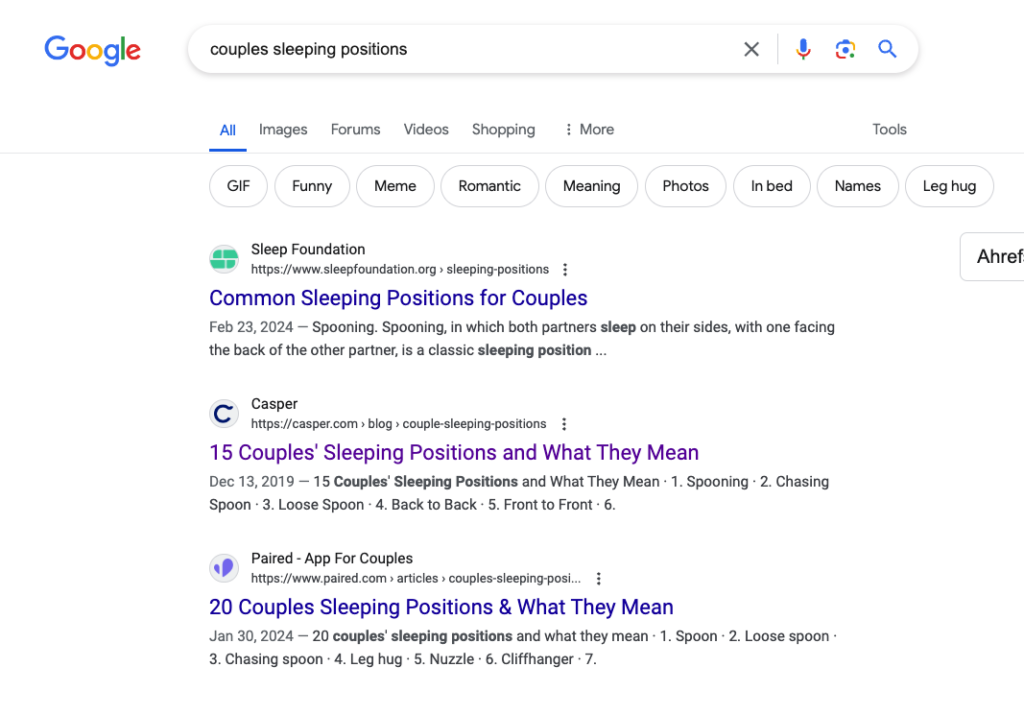
But keyword-driven content is just the tip of the iceberg. It’s my favorite from a strategic point of view, but it can be challenging to get very creative.
So, let’s get into some of the more “link-baity” kinds of digital PR.
Visual-Led Content
One of the best content types is visual-led. Photos, graphics, and data are easily shared, and stories are told through the most accessible medium.
So, let’s look at how some brands do this successfully through digital PR!
5. Signs.com Branded in Memory
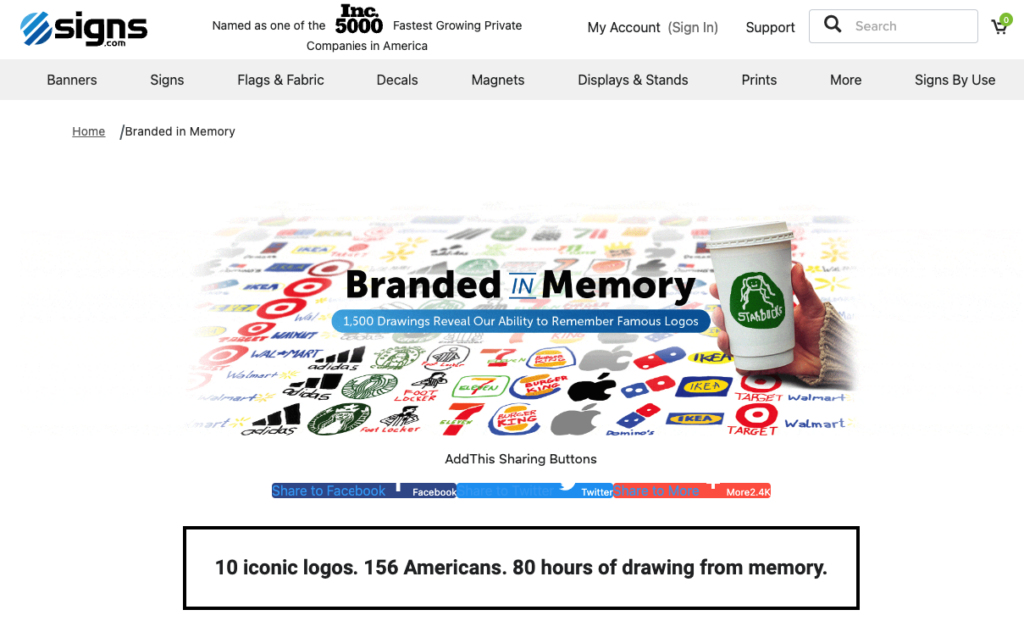
Strategy: Using an enticing graphic illustration to build links.
One of my favorite pieces of all time is one from Signs.com (so much so that I mentioned it in my talk at SearchLove in 2019.) It’s not a particularly interesting industry (no offense to Signs.com), but they have the visual aspect to lean into.
So, for this piece, they took 10 famous logos, such as Apple, Ikea, and Target, and asked people to draw them from memory.
The result is a fascinating look at how well (or not well) people can remember images and logos they see.
Take a look at the Apple logos:
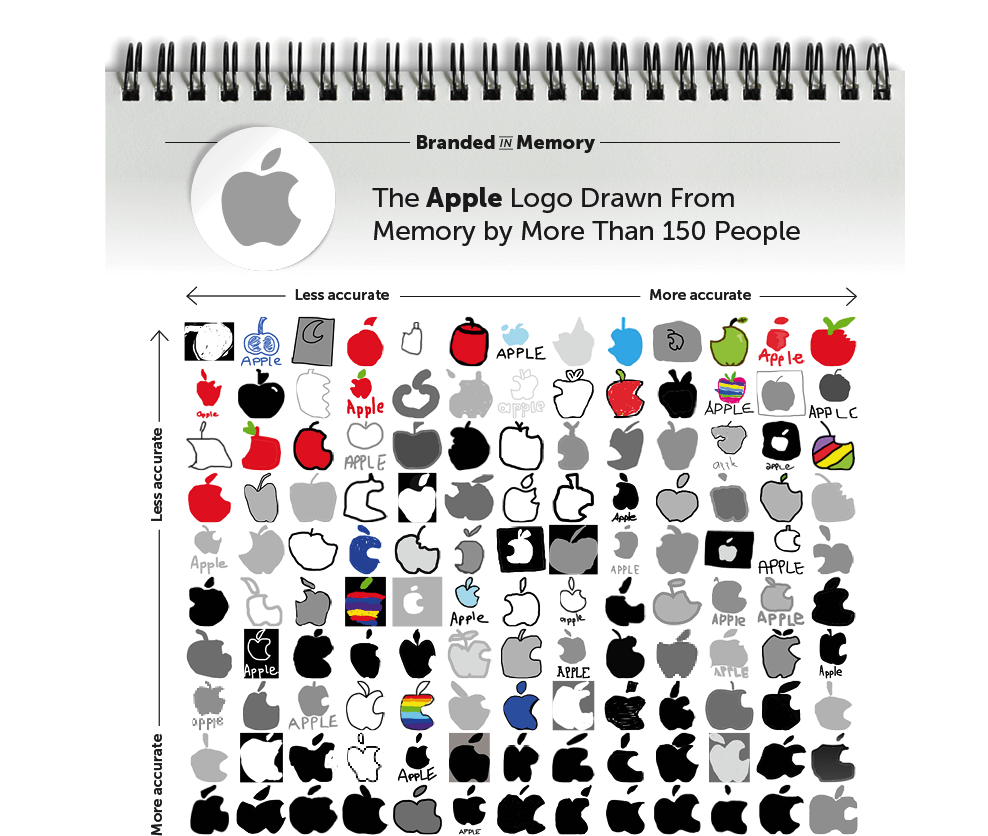
How to pitch: Because of the broad focus of topics covered, they could pitch everyone from high-end news to design sites.
Results: The resulting coverage is well over 1200 LRDs and came not only from high-end news sources like DailyMail and Houston Chronicle, design sites like CreativeBloq and Core77 but also brand-specific blogs mentioned in the piece like MacRumors.
Plus, it’s not just a flashy post designed to get links. It’s an advertisement for Signs.com.
If consumers forget what your logo looks like, your business may need better branding.
This was done in 2017, but a study like this can 100% be done today as a digital PR campaign. It’s been replicated in industries like VanMonster’s Motors By Memory from 2020, which has 200 LRD.
6. Perceptions of Perfection Across Borders From SuperDrug
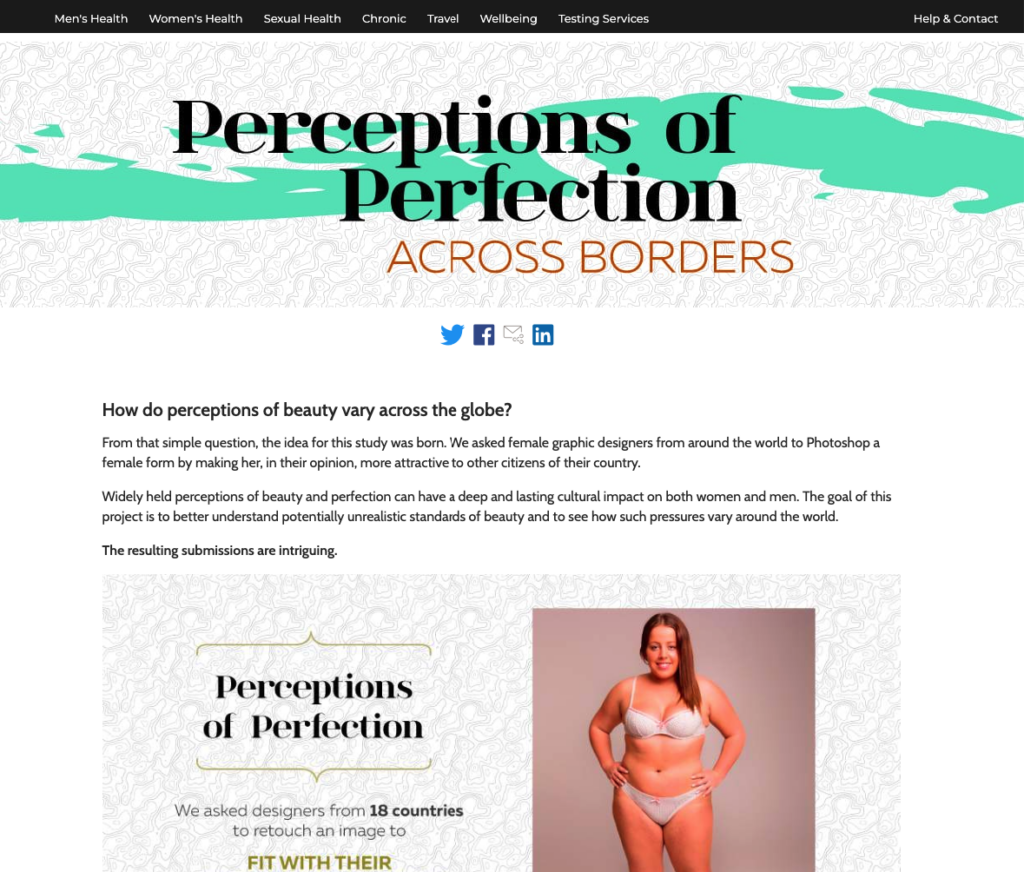
Strategy: Using an enticing photograph to build links.
SuperDrug, a remote healthcare service in the UK, took another approach to a similar concept. They asked artists worldwide to Photoshop an image of a woman, making her, “in their opinion, more attractive to other citizens of their country.”

How to pitch: Since the piece has a highlight image for various countries, they could pitch this to regional news publications in each country featured. Due to the subject matter, they could also pitch to lifestyle, wellness, or beauty sites.
Results: They earned almost 400 LRD from major publications like DailyMail, Huffington Post, and the Telegraph.
The “re-imagined” concept used to work well. We did one long ago that reimagined famous comic book strips as popular TV shows.
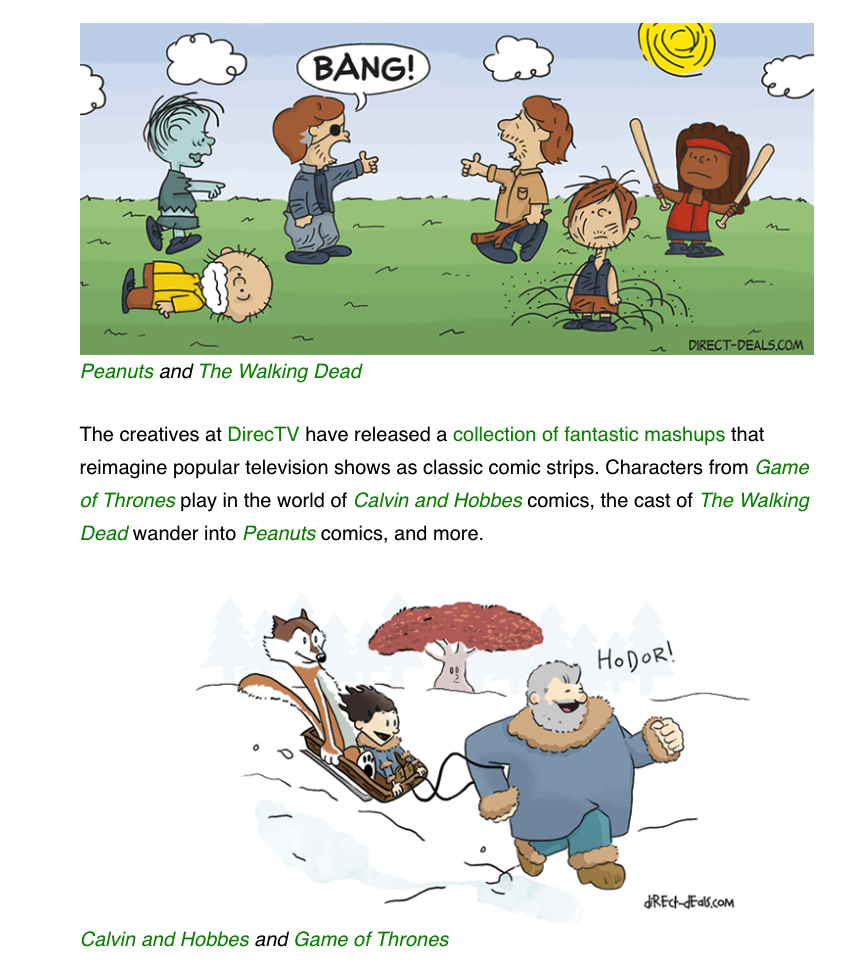
It’s still some of my favorite artwork.
However, the concept somewhat played out. Google “Disney princesses reimagined as” and you’ll see what I mean:
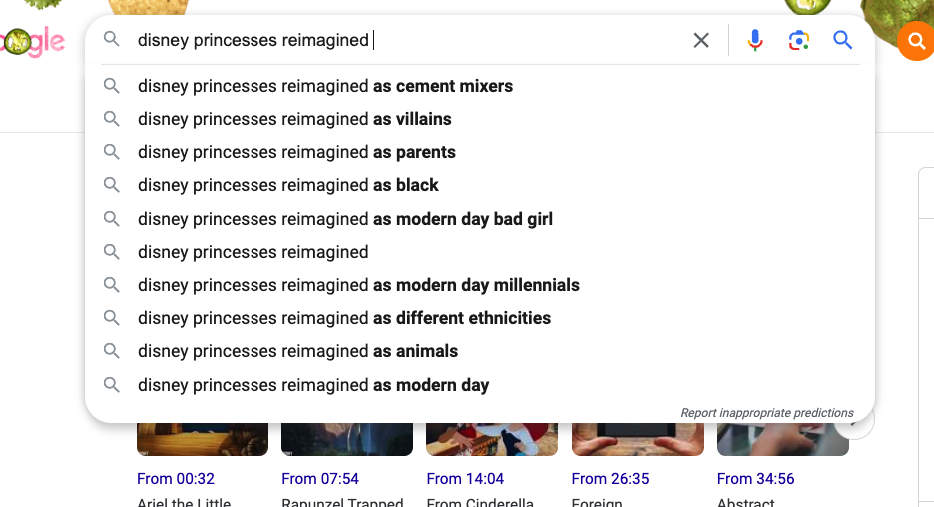
But AI image generators like Midjourney and DALL-E are breathing some new life into this.
For example, here are states reimagined as shoes, as done by KURU Footwear:

Given the proliferation of independent artists and social platforms, you’ll find that most publications are more likely to share artist renditions rather than major brands.
I’ve found that data visualization is the better option these days. Let’s examine an example.
7. WriterBuddy AI Tools Industry Analysis
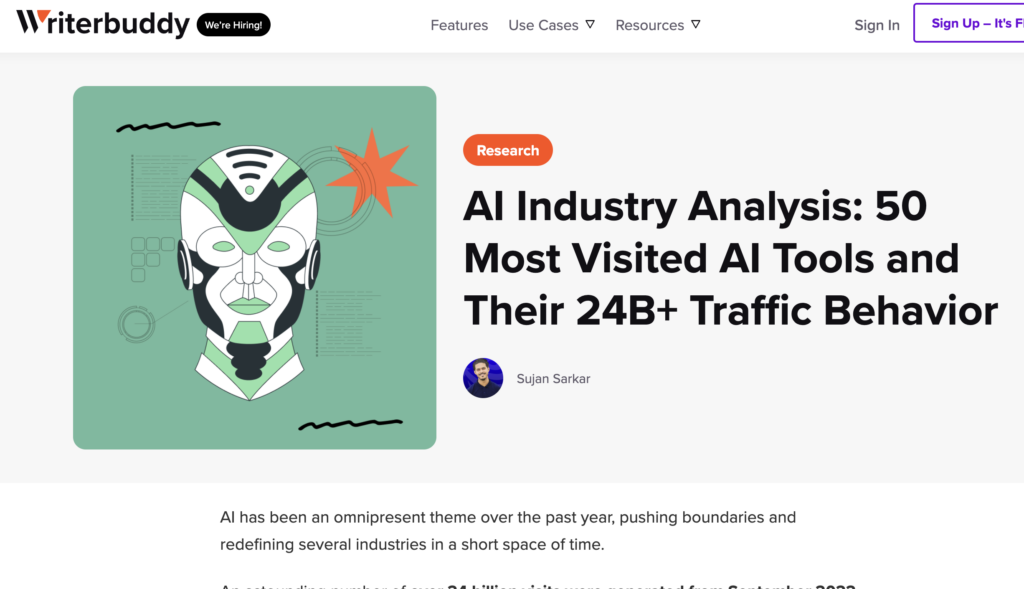
Strategy: Using an enticing data visualization to build links.
To me, a graph isn’t data visualization. Technically, it is, but it typically isn’t interesting enough to inspire coverage on its own.
So, let’s look at how WriterBuddy made data more exciting and visually engaging.
They investigated the available AI tools, such as ChatGPT or Bard (now named Gemini), and explored the traffic they received in a given timeframe.
Then, they created a shareable data visualization:
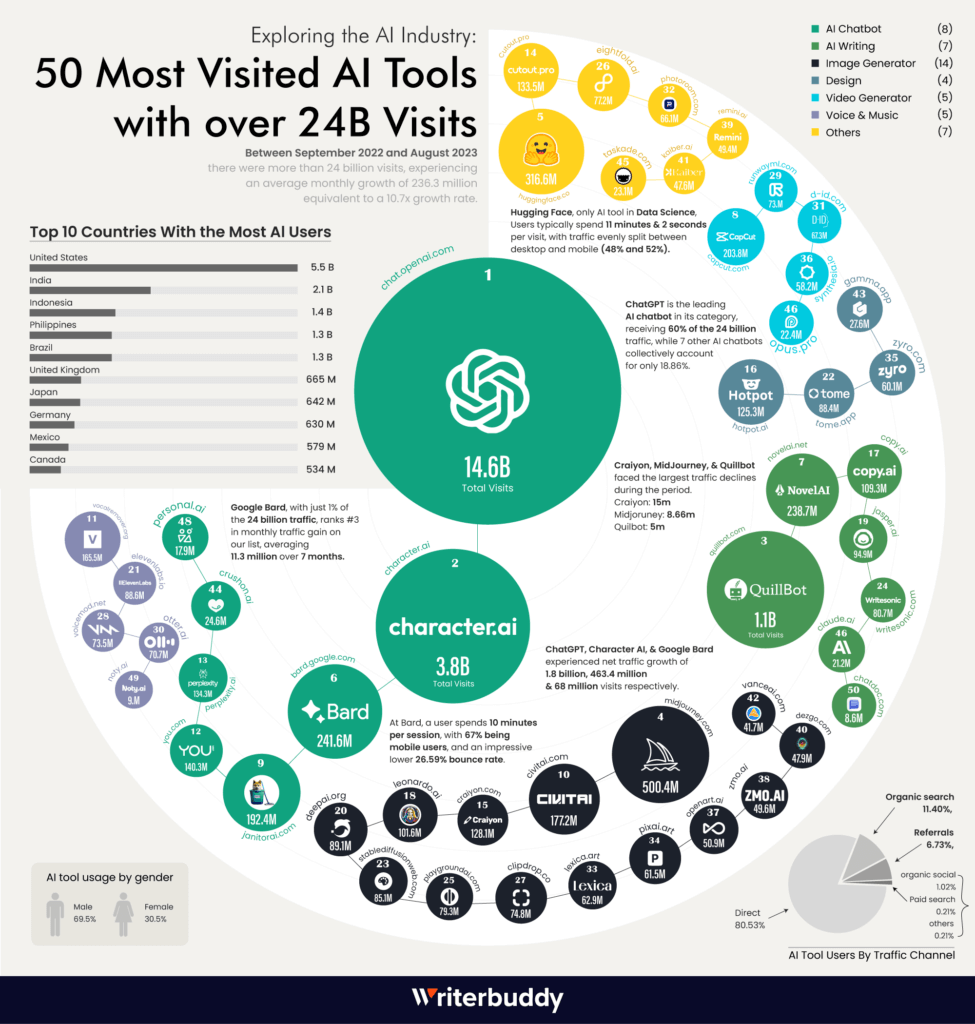
How to pitch: The pitch process is more impactful with a shareable visual because sometimes the visual can do the heavy lifting for you. I recommend putting the visual right into the email pitch. A picture says a thousand words.
One note is that visual-led content only works when you invest in the design of a post. The above visual might cost ~$1-2K from a good data visualization artist. But as you can see, the results below show that it is a good investment.
Results: They ended up close to 700 LRD with major coverage from publications like Forbes and Cnet.
As you can see, you can also use data to drive stories and power visuals. So, let’s shift focus to data study types in digital PR.
Data-Led Digital PR
This section overlaps with some previous sections in terms of content type and presentation, but since data-led campaigns are one of the best ways, if not the best way, to win in digital PR in 2025, I think it deserves its own focus.
From an SEO perspective, providing new data and research is one of the things that Google mentions in their Helpful Content “self-assessment.”

As Google continues to roll out AI features, it will continually seek new data points to feed its LLM.
You can pull third-party data from government sites, online databases, APIs, and hundreds if not thousands of other sources. If you’re lucky enough to have proprietary data, that’s the best.
So, let’s start there.
8. Insurance.com’s Most Ticketed Cars
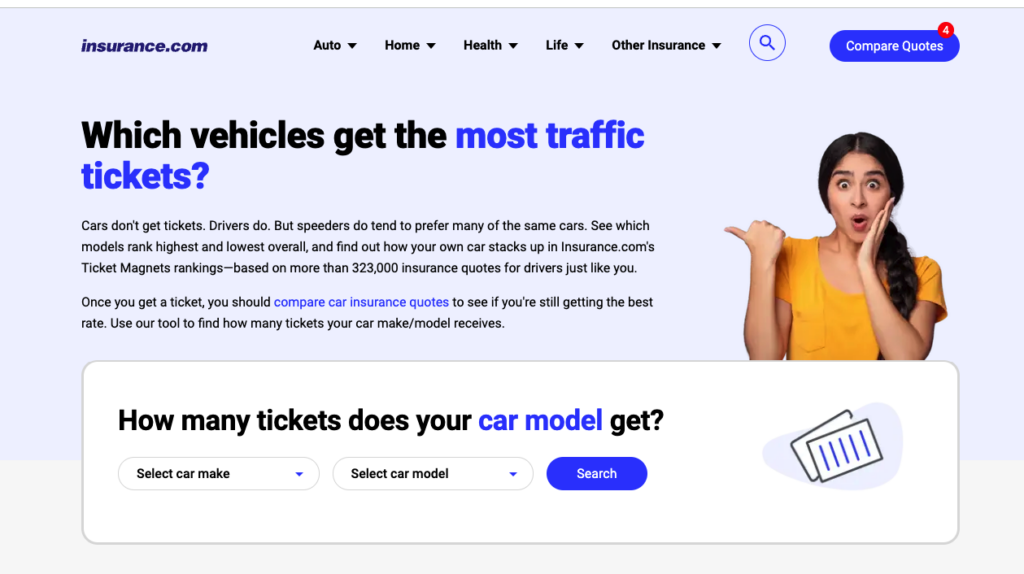
Strategy: Using internal data to create a pitchable post.
Insurance site Insurance.com lets you compare quotes for various insurance types. As users fill out online forms, they constantly collect data.
For instance, to get auto insurance quotes, the tool asks for your car’s make and model and the number of tickets you’ve received.
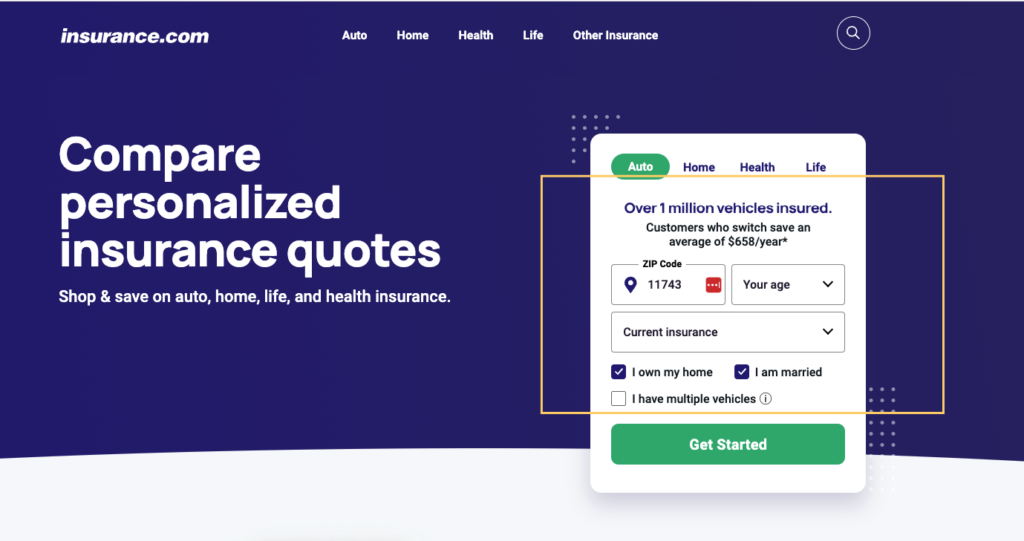
So, after realizing they were sitting on a treasure trove of interesting information, Insurance.com decided to use this data to create a piece of content showing how many tickets your car model gets.
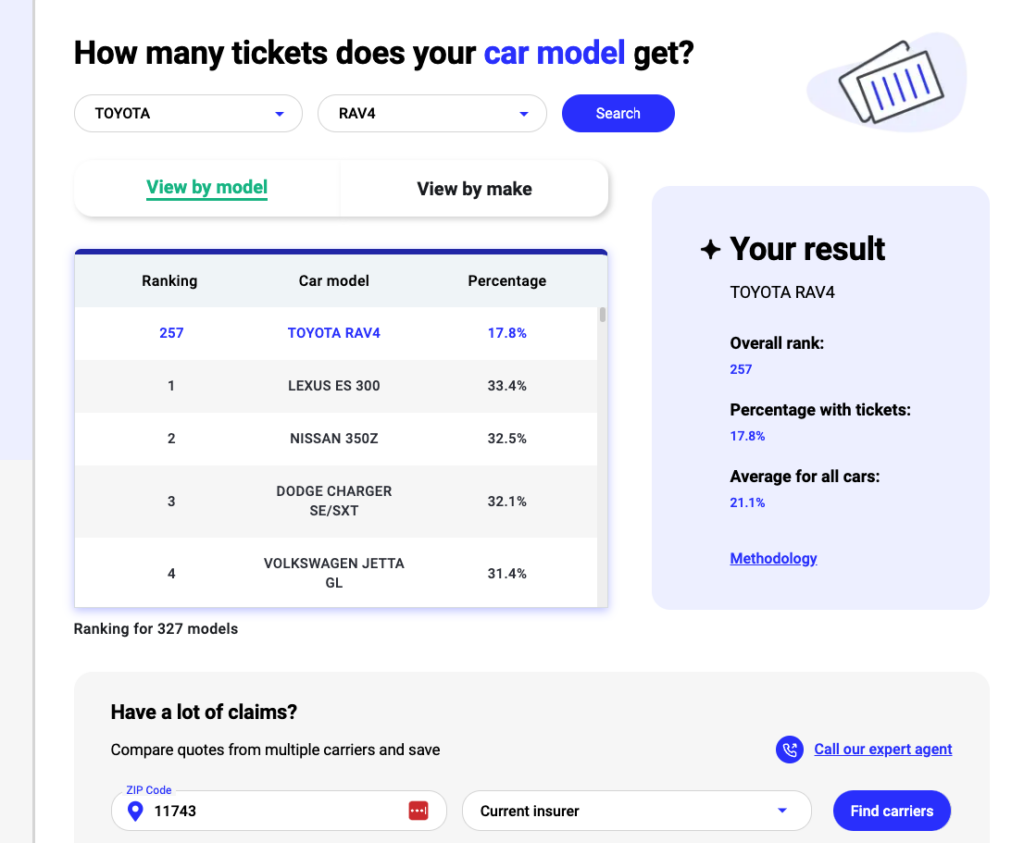
How to pitch: This approach lets Insurance.com pitch to journalists covering the auto industry and auto sites, but since it has an interactive element that makes the user the star, they can also pitch to general news sites.
Results: This got over 90 LRD from sites like Forbes, MSN, and USA Today and many auto sites like MotorTrend and TheDrive.
However, not all sites have access to internal data sets like Insurance.com, but you can create your own proprietary data through third-party survey platforms. Let’s look at that next.
9. MattressNerd Nation of Nappers
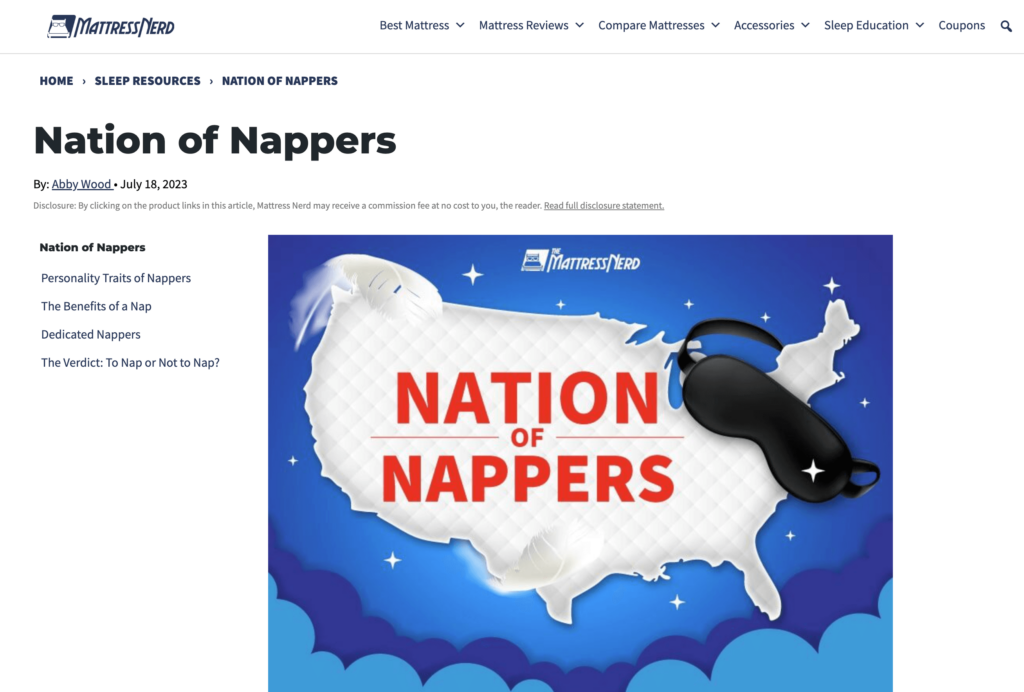
Strategy: Using survey data from a full-service paid platform to create a pitchable post.
Mattress review sites are trendy. So, it’s essential to stand out in any way you can. MattressNerd went the digital PR route to gain links and eyeballs on their brand.
They used a paid, third-party survey platform, OnePoll, to gather responses from 2,000 people about their napping habits.
The study found interesting insights, such as that nappers are more productive than non-nappers and that others would take a pay cut if they could nap on the job.
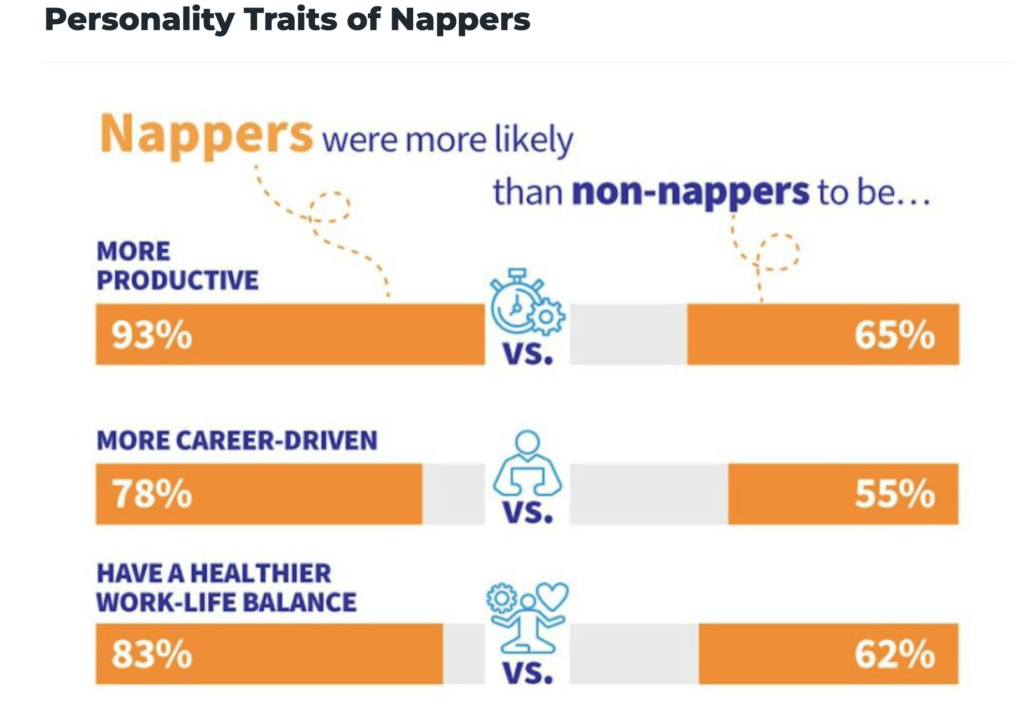
How to pitch: This approach allows them to pitch to relevant sites or blogs about sleep and lifestyle or general news publications.
Results: Ultimately, the piece has over 90 LRD and coverage from top news sites like the NY Post, Huffington Post, and the Sun.
10. Preply’s Why Are Americans Obsessed with Subtitles?
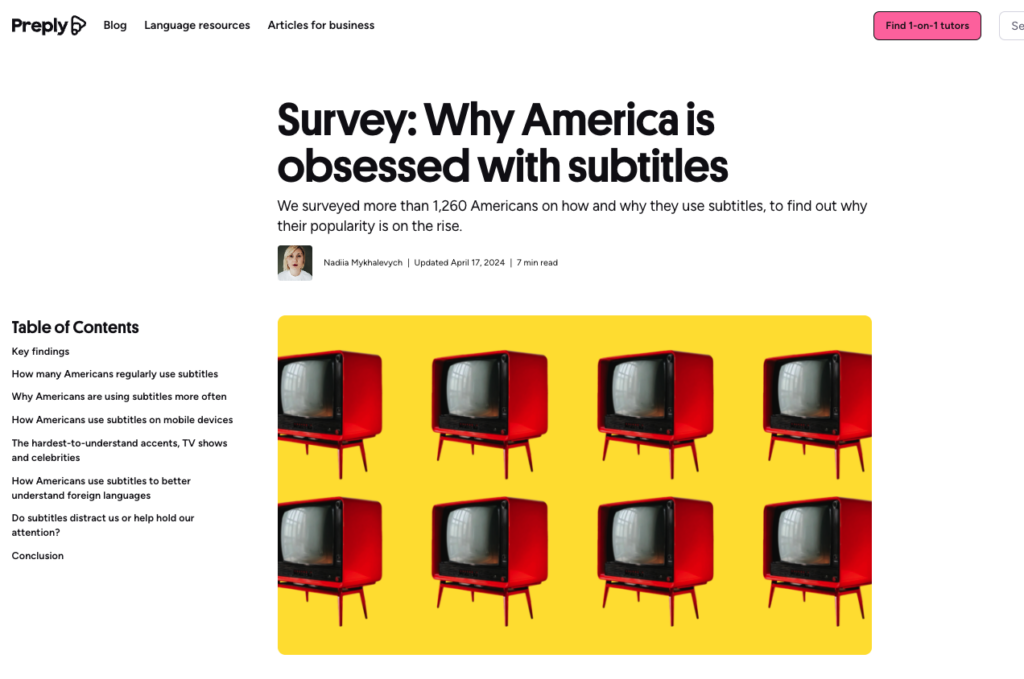
Strategy: Using survey data from a self-service platform to create a pitchable post.
Preply is a peer-to-peer language tutoring site. So, communication is an excellent arena for them to play and ideate in.
They studied subtitle use based on a stat about how younger generations prefer to watch content with subtitles.
They asked general subtitle usage questions and which celebs were hardest to understand (Tom Hardy, of course!).
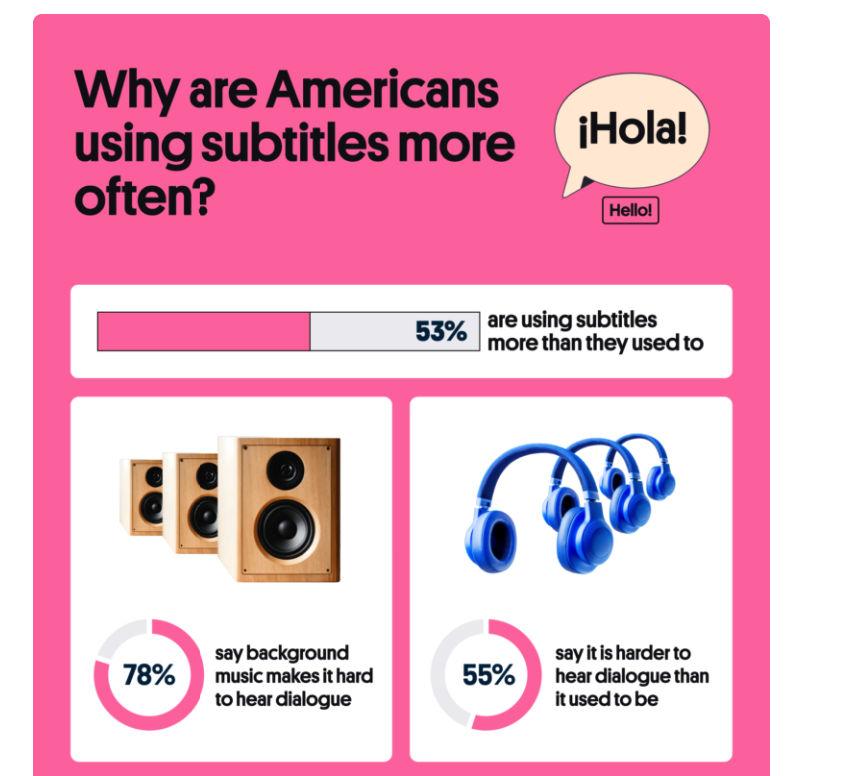
And to tie it back to Preply, there was even a question about using subtitles to understand a foreign language better.
How to pitch: This can appeal to mass audiences, making their prospect list every general news pub. However, it could also narrow the focus and pitch to movie and TV-related publications and blogs (which number in the thousands).
Results: The survey tapped into something special because it ended up with over 800 LRD, including coverage from the New York Times, Wall Street Journal, TimeOut, ArsTechnica, and foreign sites like Observatório docinema and El País.
11. Angi Home Renovations Confidence Survey
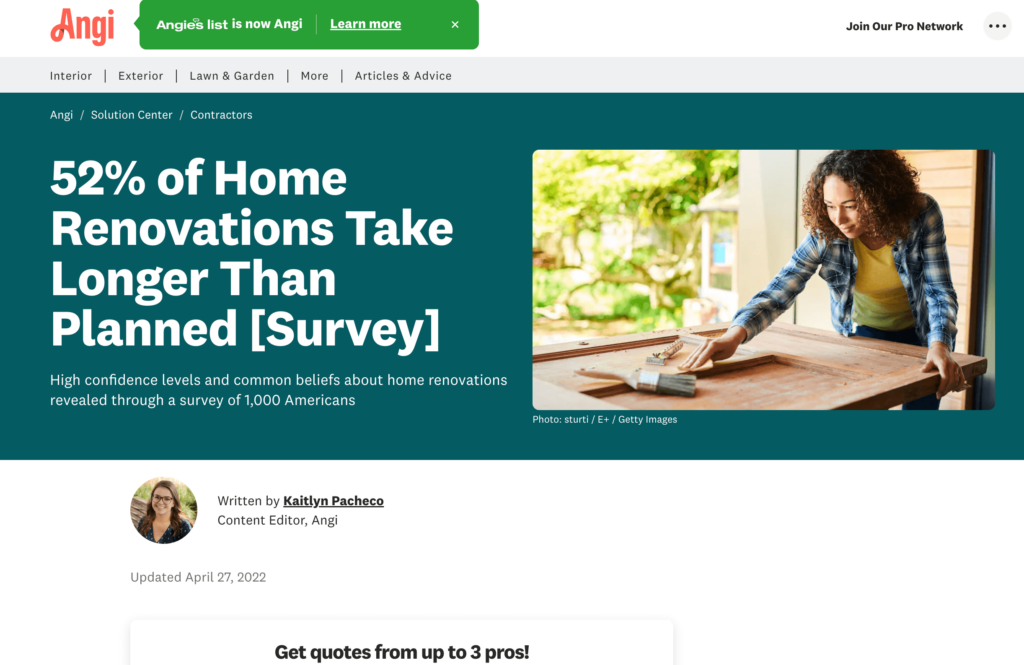
Strategy: Using survey data from a full-service paid platform to create a pitchable post.
Angi is an online marketplace for those looking to connect with professionals for home projects and services.
So, it makes sense for them to lean into a home renovation survey.
There is always some trepidation about starting a home renovation project, so this study leaned into that. They asked how people feel about the home renovation process, whether they add value, whether DIY is better, etc.
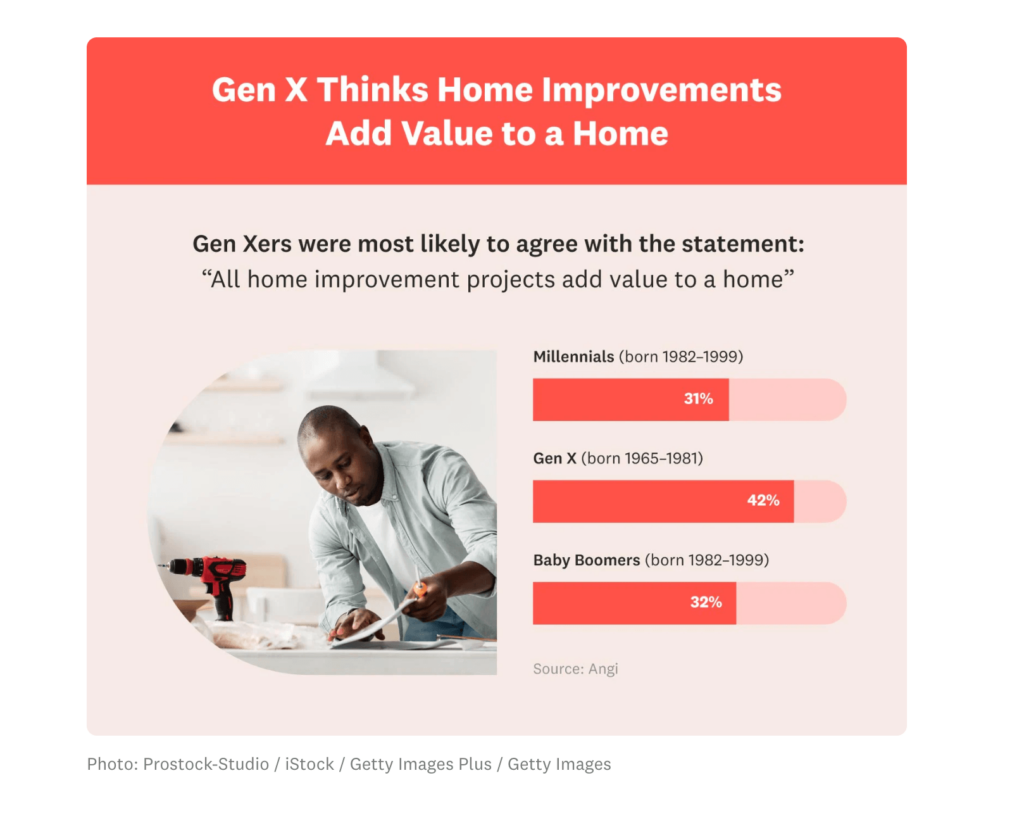
How to pitch: In our email outreach templates post, we outline great ways to pitch surveys like this one. This survey has a finance and home improvement angles, appealing to a large audience of high-authority publications.
Results: The piece ended up with over 50 LRD, with coverage from major publications like FoxNews and industry-relevant publications like realtor sites.
Some journalists say that the survey platform affects coverage, so let’s look at one more digital PR example: YouGov, which uses a third-party survey platform to gather data.
(I’m not saying one is better, but since this is a post of examples, I want to show as much range as possible.)
12. ResumeBuilder’s AI Interview Study
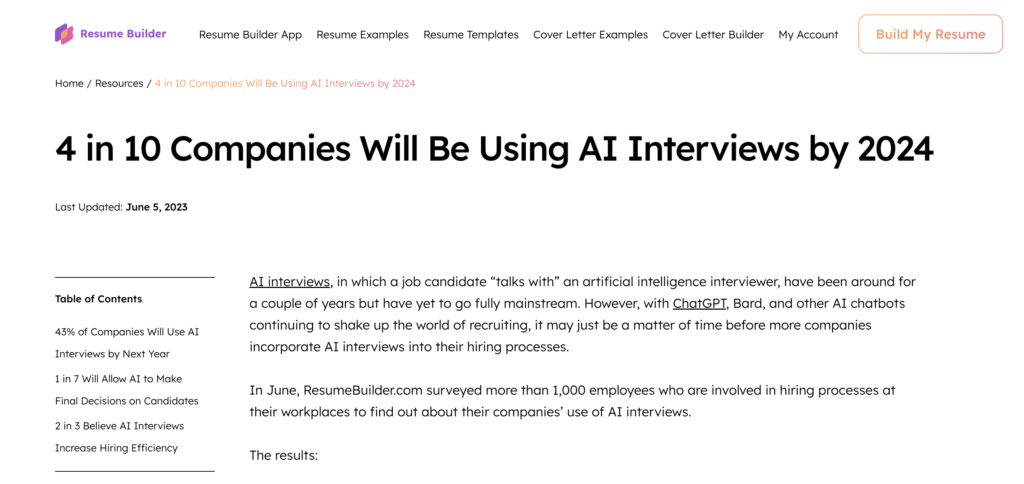
Strategy: Using survey data from a full-service paid platform to create a pitchable post.
Many content creators gather data from self-service platforms like YouGov, SurveyMonkey, and Pollfish.
One study from ResumeBuilder.com used SurveyMonkey to craft a survey around the interview process from a company hiring standpoint.
Although this doesn’t necessarily relate to their core audience of job seekers, it is still more than relevant enough to build authoritative links from the right kinds of sites.
Their campaign asked employees involved in the hiring process to determine whether and how they’d use AI in the interview process going forward.
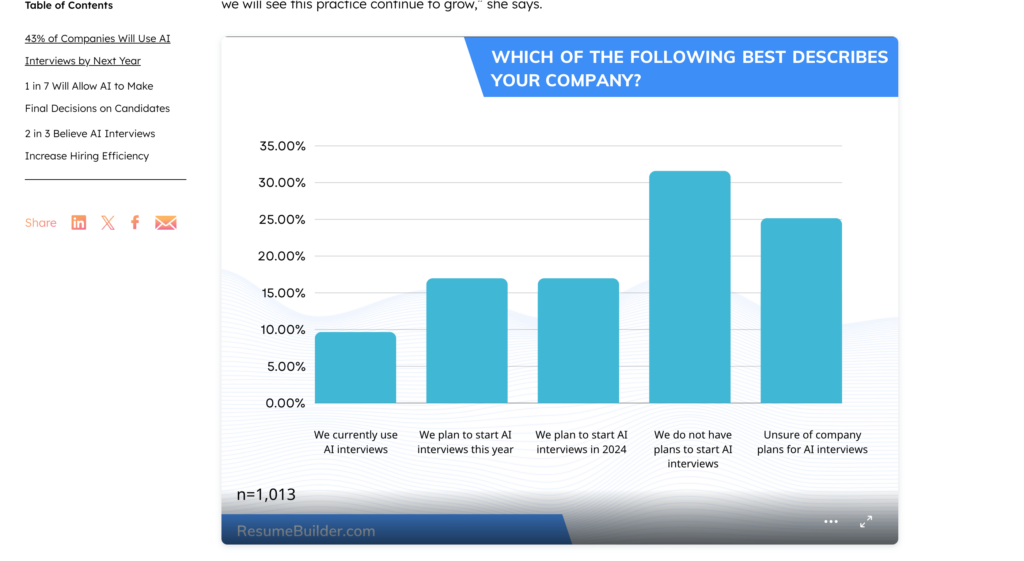
The study had interesting findings, such as AI being mainly used for screening questions. A survey like this for ResumeBuilder can help bring relevant, authoritative links to their site.
How to pitch: This topic allows ResumeBuilder to pitch to general technology-focused sites, small business sites, and the HR/job-seeker market, which is right in their wheelhouse.
Results: They received over 160 LRD from sites like ZDNet, CBSNews, and NBC, as well as industry-related sites like Workable and HRDaily.
Self-service platforms are typically cheaper than full-service, so some opt for self-service. But let’s look at an example from full service next.
With some of these surveys, successful brands will try to run it back annually, quarterly, or monthly.
If you have a data-savvy team, you can get creative with collecting data in other ways.
13. BuzzStream’s State of Digital PR
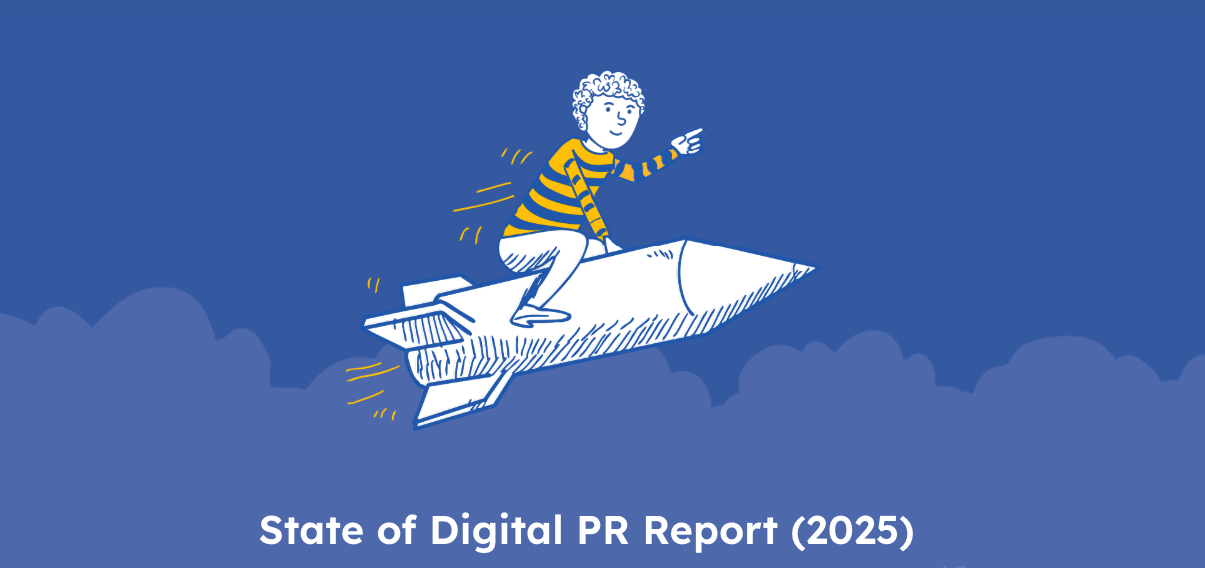
Strategy: Surveying using a free platform like Google Forms.
Surveying a targeted audience —even with a self-service platform— can quickly become costly. We wanted to keep costs low for this report, so instead of using a self-service tool and asking screening questions to drill down our target audience, I relied on LinkedIn and built my list naturally.
Industry trends reviews and reports can position your site or company as a thought leader.
The other benefit is that you can use your collected information to buff up your other posts. In one of our podcast episodes, Ross Hudgens referred to this approach asproduct-led digital PR, because the data you are gathering can be used on other parts of your website.
For us, it also helped build out digital PR statistics post.
To build the survey, I focused on our audience and provided valuable data. (To ensure that it was truly valuable I even emailed some thought leaders in the space some of the questions ahead of time to see what they would really find interesting.)
Then when it came time to run the report, I used Google Forms as my question platform.
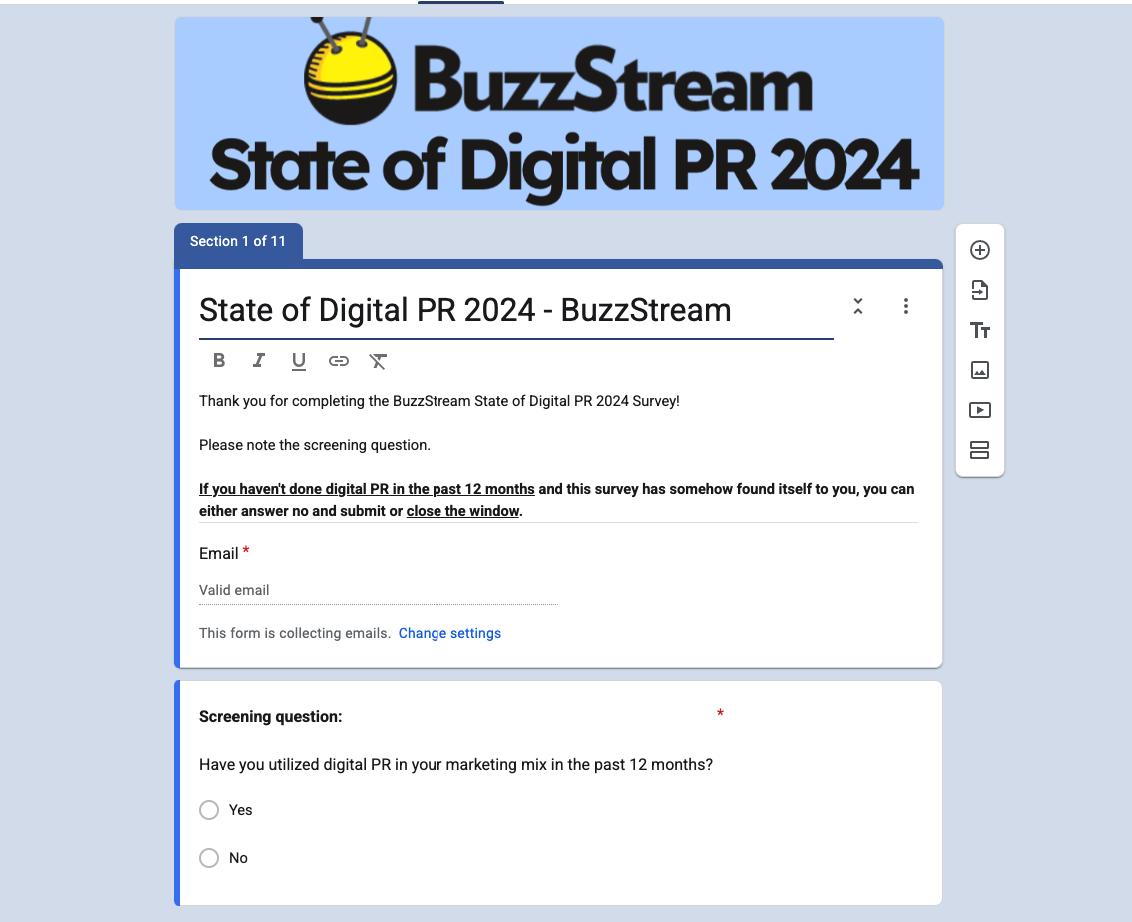
This gave us a reliable dataset that we could analyze and visualize.
After I ran the survey, I then visualized everything using Infogram.
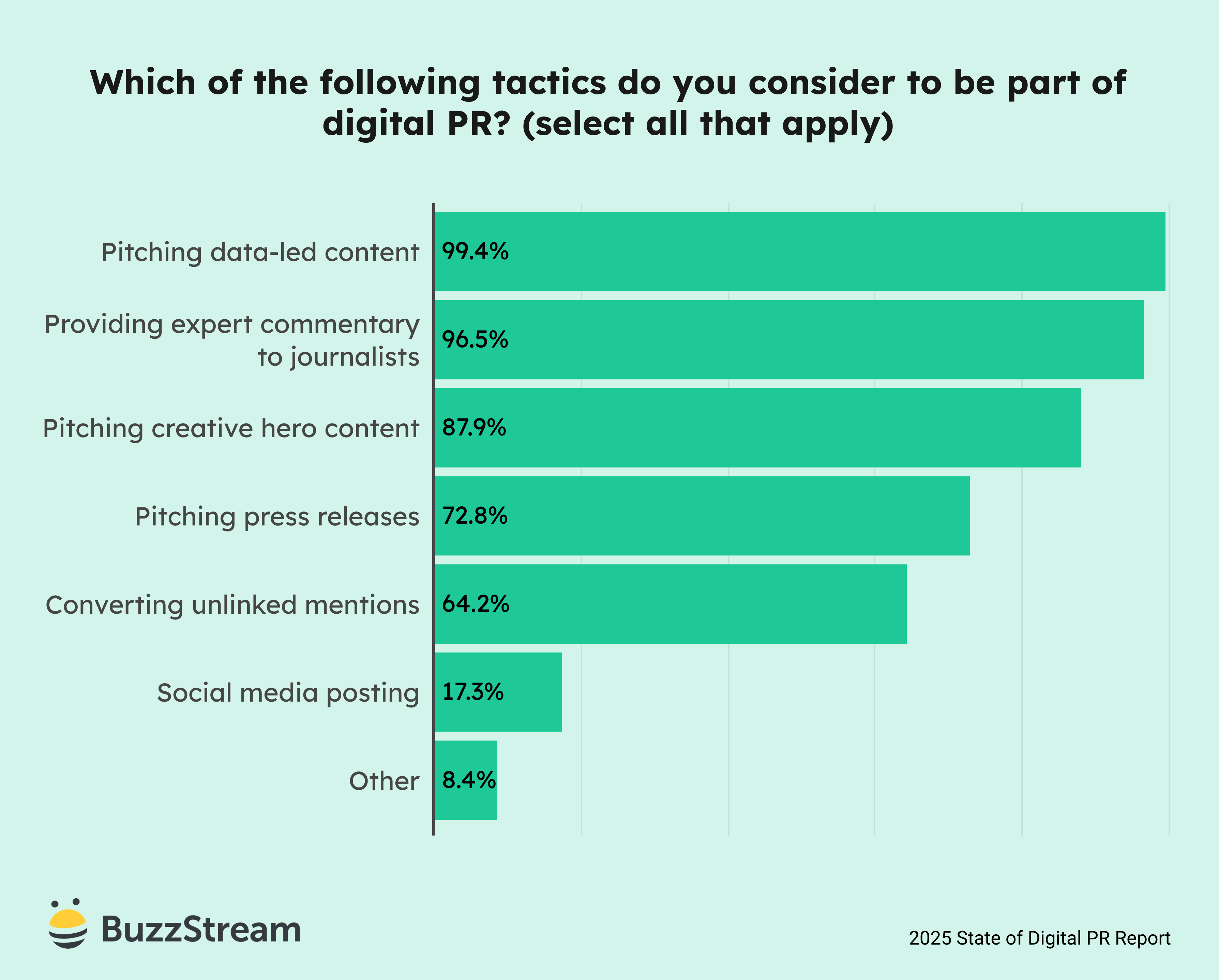
Then, with the help of our developer, we presented it as you see now.
How to pitch: Industry news sites love this kind of study content. In our case, we also included a lot of influencers within the post in hopes that they can help extend the reach as well.
Results: This campaign is still active but is getting a lot of play on social media and mentions in industry newsletters.
14. BuzzBingo’s Profanity in Film
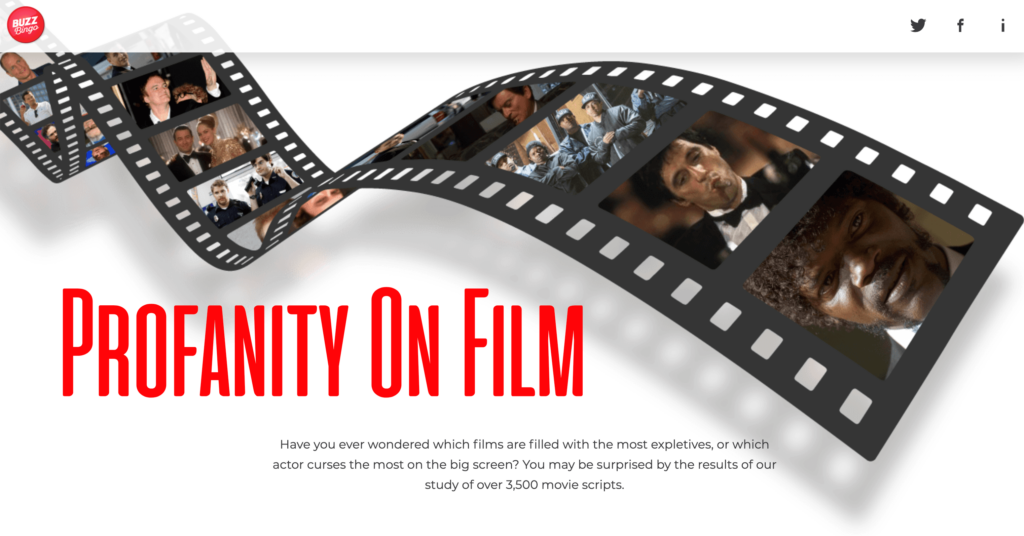
Strategy: Using scraped data to create a pitchable post.
Scraping tools like Webscraper.io or ScrapingBee allow you to scrape any available dataset online.
This is a great way to unearth or analyze data that may otherwise be hidden or too time-consuming for journalists and publishers to find. If you can find a good angle, it can be extremely sharable.
Online gambling site BuzzBingo found a tremendous f*ing angle.
Using scraping tools, BuzzBingo looked at the text from 3,565 film scripts, cross-referenced them with lists of curse words, and then ranked the films and actors with the most profanity.
They also looked at swearing over time to add other angles for pitching.
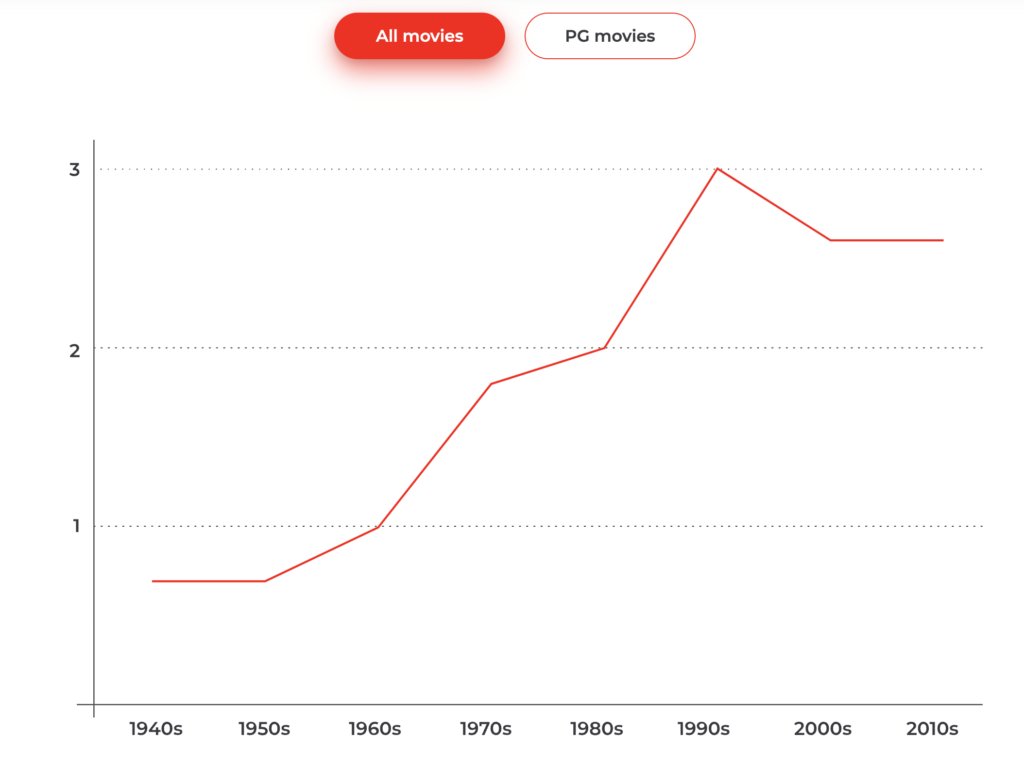
How to pitch: With a film-focused post, they could really dive into high-authority cinema sites, but because they also focus on celebrities, they could tap into mass media news as well.
Results: This campaign garnered over 800 LRD from top publications and social media mentions from actual celebrities like Jonah Hill and Samuel L Jackson, who were mentioned in the study.
Sometimes, the data for your survey doesn’t exist yet, so you need to find it yourself.
15. Backlinko’s Voice Search Study
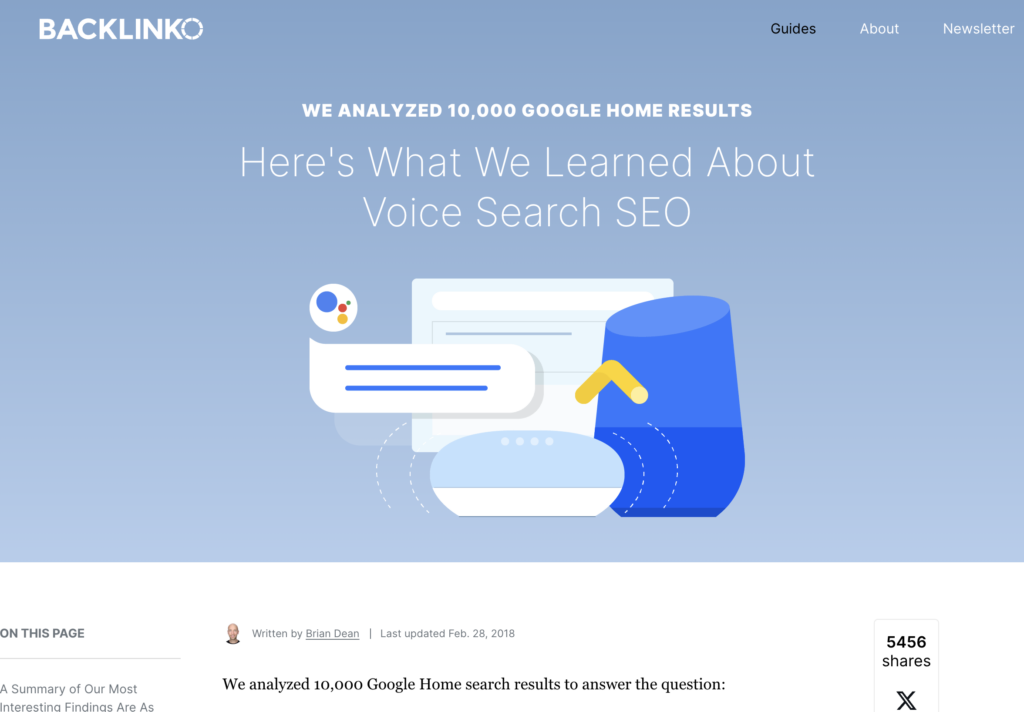
Strategy: Using manually gathered data to create a pitchable post.
Backlinko’s Brian Dean was on our podcast in an episode about using data trends. He talked about a study he did for Backlinko right when a voice search came out.
As an authority in the SEO space, he wanted to dive into the new world of voice search.
No datasets existed, so he was forced to gather the data old-fashioned: manually asking 10,000 questions to a Google Home and recording the answers to create a proper data study.
The study looked at data points such as response length, reading level, and the pages on which it appeared.
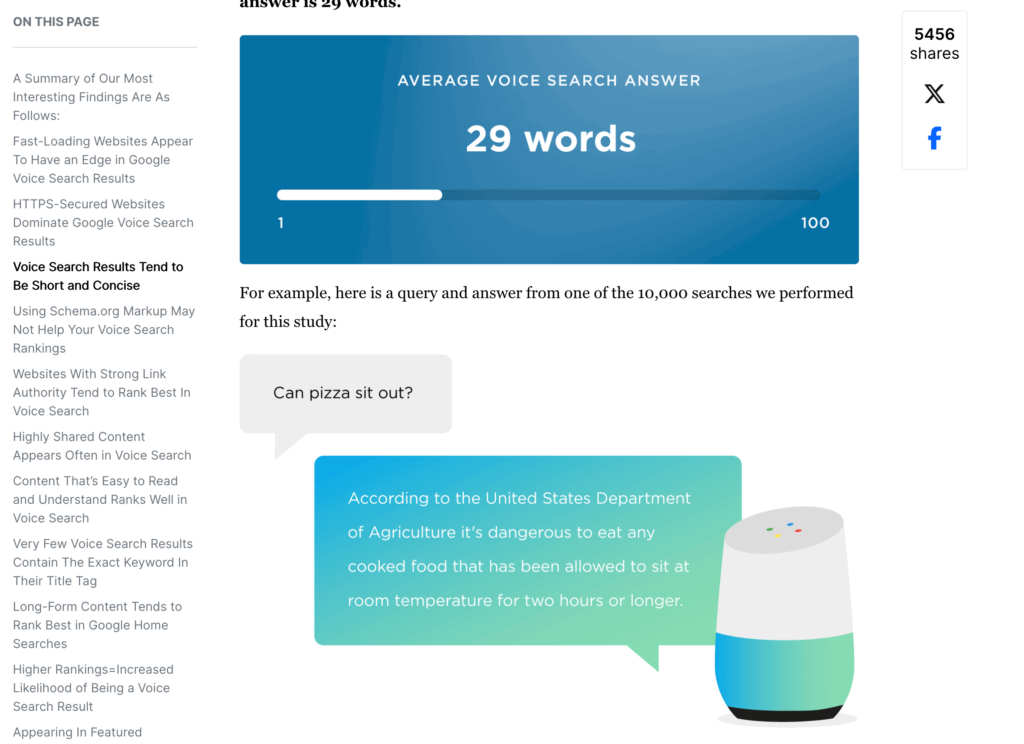
How to pitch: Since this post bridged the gap between tech and marketing, it can appeal to both markets. And since the data collection method is unique, you could even mention that in the pitch (I’m not sure if Brian did).
Results: The current number is over 3000 LRD, with links from Inc, Entrepreneur, and Forbes, as well as industry-relevant coverage from Wix, Hubspot, and SEMRush.
In Brian’s words: “If you’re willing to put in that little elbow grease, you’d be surprised what you can accomplish with this sort of stuff.”
If you succeed with a single study, you can sometimes repeat it with new data for the next year.
So, let’s dive into some examples of recurring digital PR content next.
Recurring Content
Some brands release recurring content to refresh data, establish trends, create anticipation and buzz from journalists, or all three.
Let’s look at a few successful examples of those.
16. Bankrate’s Annual Emergency Savings Report
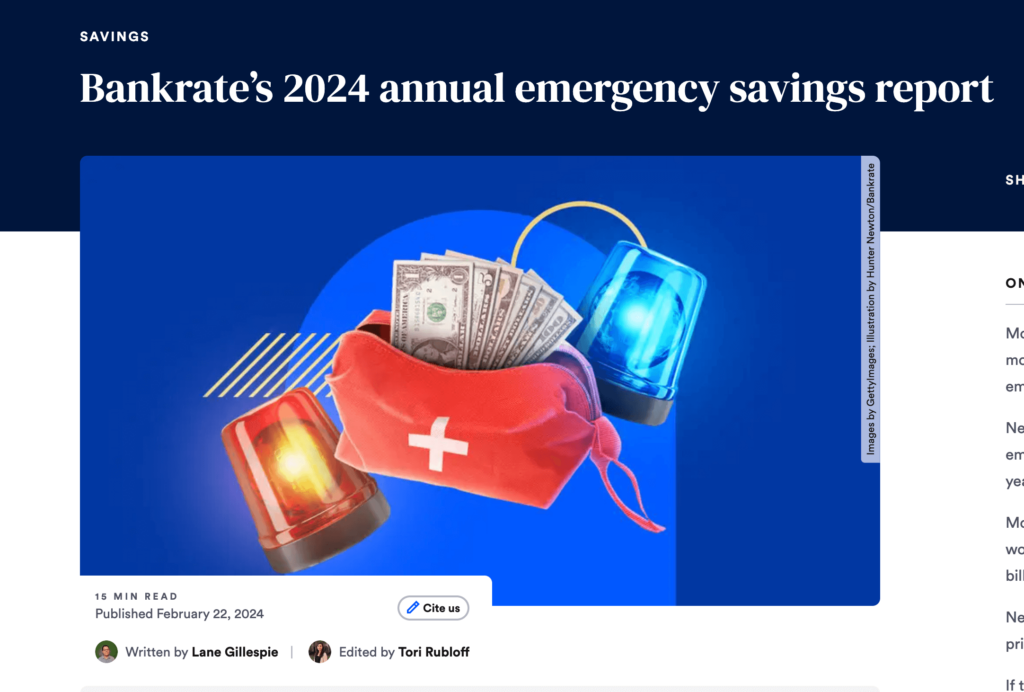
Strategy: Establishing an annually-recurring, data-led piece.
Bankrate covers all things financial.
They have been around for a long time and have garnered a lot of authority in that time.
They keep getting eyeballs on their content through recurring surveys, like their Annual Emergency Savings Report for 2023 and 2024.
In it, they survey Americans about their saving habits, including how much they save, how highly they prioritize saving, and more.
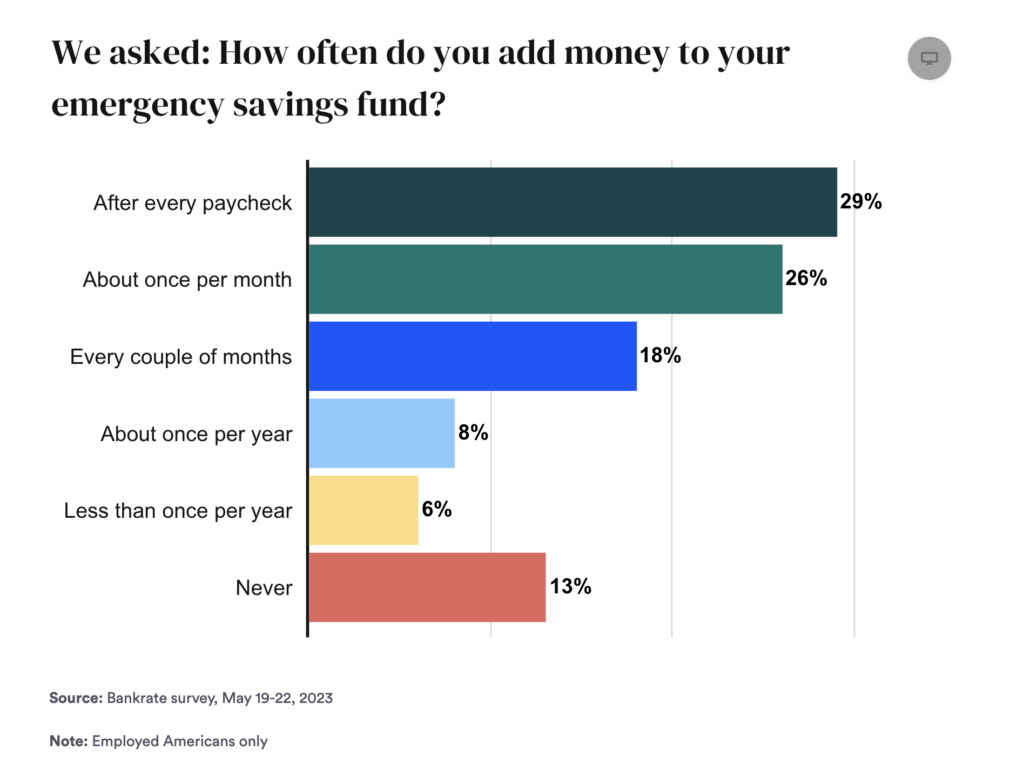
How to pitch: This is a financial piece that addresses a general population, so any news site would fit in a pitch. Since it’s a recurring post, it’s essential to call that out in the pitch and focus on any gains or losses from the previous post.
Results: The resulting coverage is massive. And the fact that they publish on the same URL each year allows for cumulative link gains.
The post currently has over 8,000 LRD, and the bump will be visible in 2024 when they re-release their new survey.
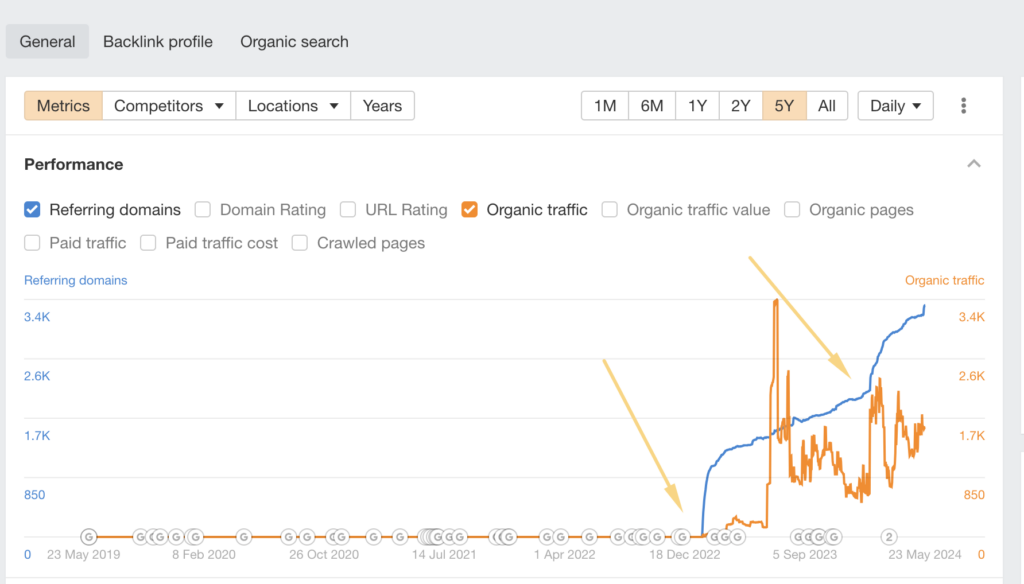
However, yearly studies can be extensive, and some don’t want to wait long between publications. So, let’s look at a monthly report next.
17. CNBC|SurveyMonkey (Monthly) Workforce Survey
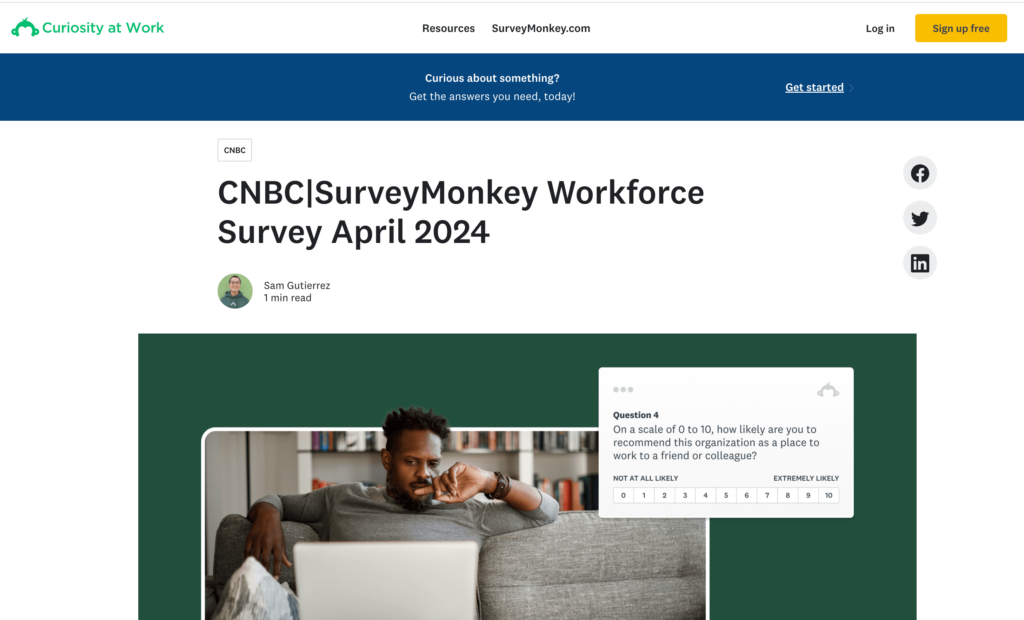
Strategy: Establishing a monthly data-led piece.
Speaking of SurveyMonkey, they are also involved in digital PR.
Given that they are a survey platform, it’s only fitting that they run a survey campaign.
They publish a monthly Workforce survey as part of a co-marketing collaboration with CNBC.
It asks questions covering the gamut of employee happiness, such as whether they want to start their own business, how enthusiastic they are about work, and how open they are to discussing politics.
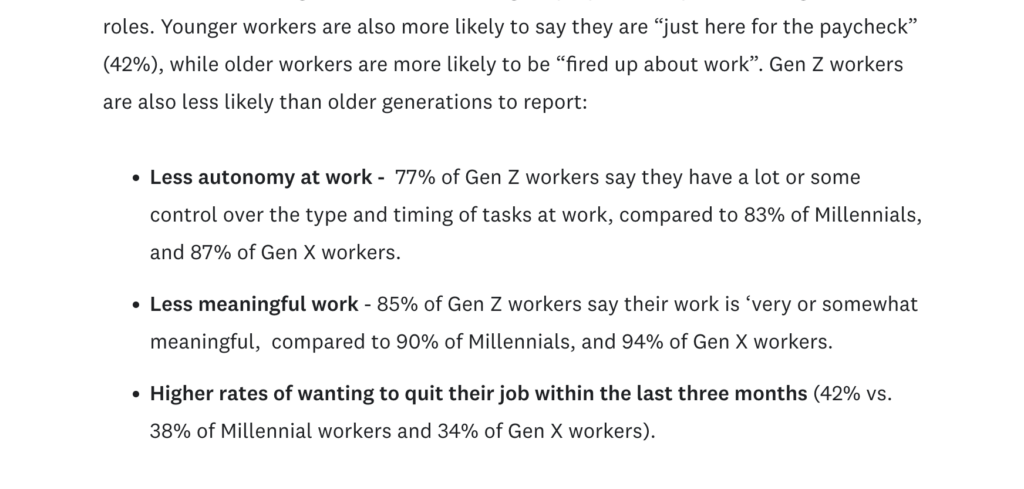
How to pitch: Employee happiness appeals to HR and job seeker markets, but it can also fit in high-authority wellness sites, as mental health is playing a much more significant role in the news these days.
The fact that this is monthly allows them to highlight trends and changes, making the story much more enjoyable for journalists who want to cover it.
Results: Each month gets about 30-75 LRD and coverage from relevant, high-authority sites.
Getting Regional Coverage
The region coverage game is a highly successful strategy for many digital PR agencies and brands looking to generate news links.
I also referred to them in the keyword-driven section at the beginning of this article, but we’ll go a little further here.
It has one of the broadest outreach markets, allowing for extensive coverage.
So, let’s look at a few versions of this.
18. Expensivity’s Burger Economics
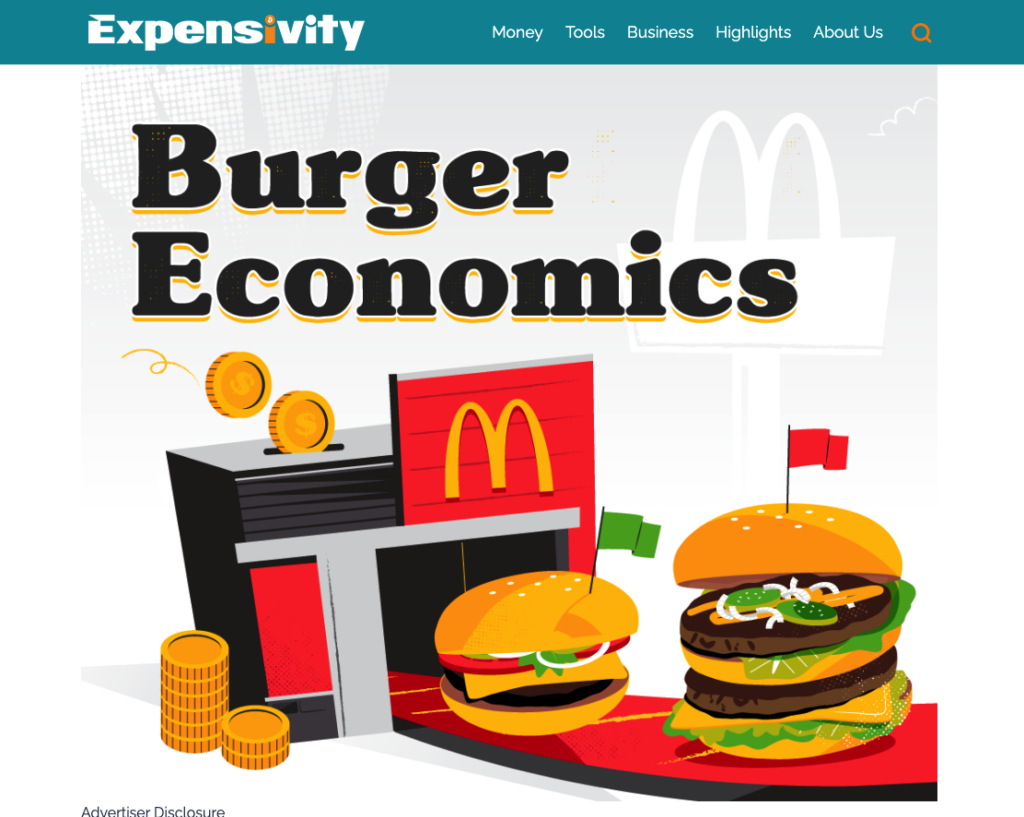
Strategy: Creating a piece for worldwide coverage.
Expensivity is a financial information site that covers topics like investing, credit cards, and insurance.
These sites (like Bankrate) are very competitive, so I’ll show you how Expensivity leans on digital PR to get links and help build authority.
In this piece, they looked at the price of McDonald’s in every country.
This interesting approach compares common benchmarks, such as the price of a Big Mac and a Happy Meal, in every country.
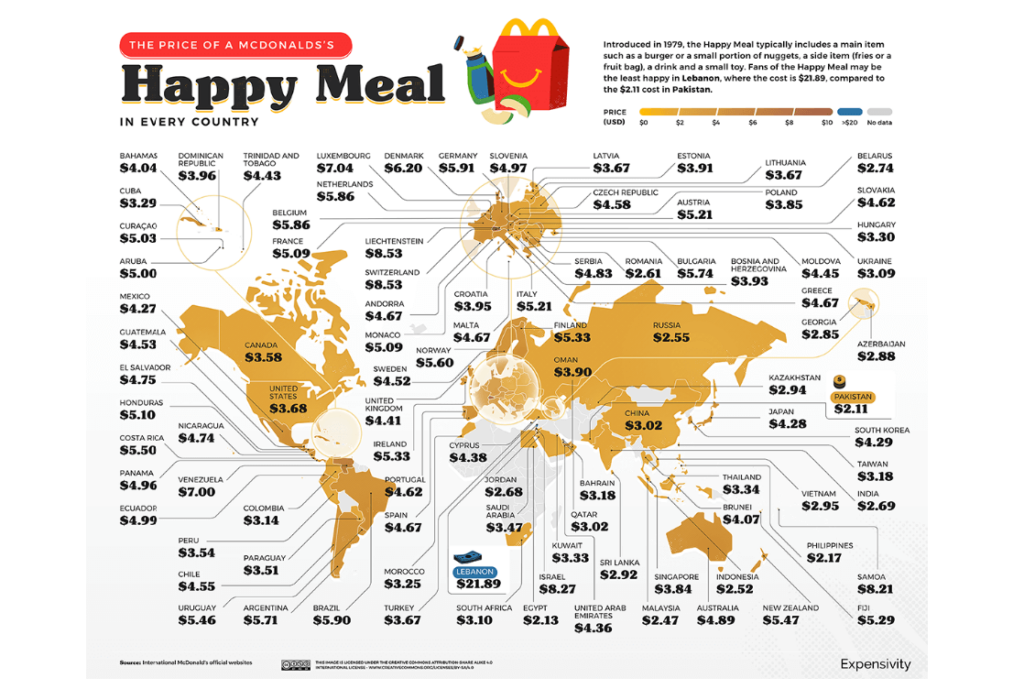
How to pitch: By focusing on every country, they could pitch this worldwide. As discussed in the data-led and visual section, a solid visual component makes it easier for journalists worldwide to understand.
Result: The result was over 100 LRD, including coverage worldwide, including the UK’s The Sun, Canada’s Globe and Mail, and Japan’s Big Globe.
19. Wordtips’ United States of Cussing
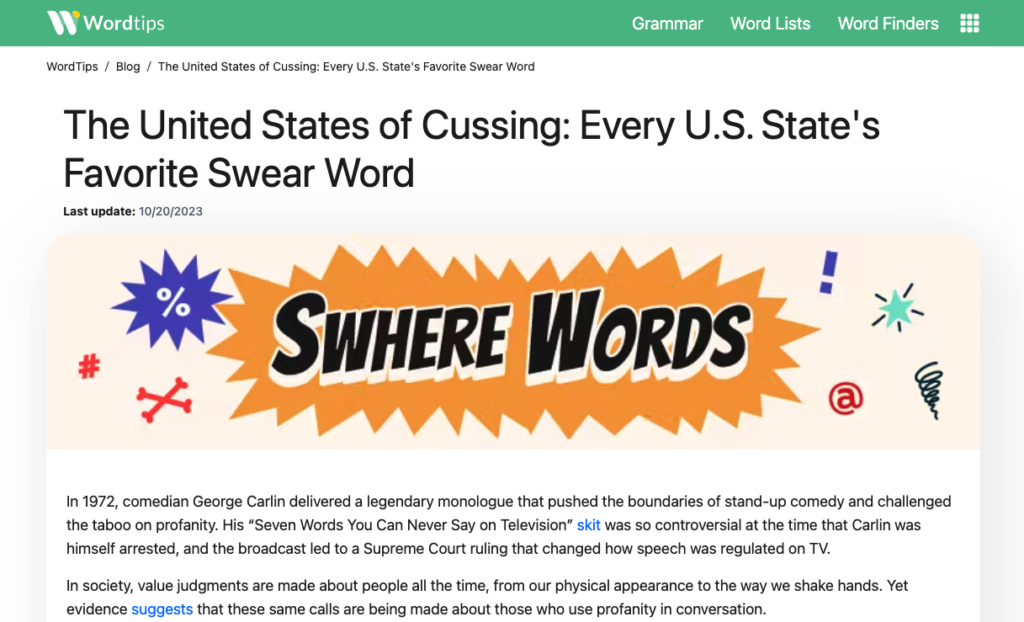
Strategy: Creating a piece for national US coverage.
As we saw in the post about Profanity in Film, curse words get links.
So, WordFinder site Wordtips also decided to lean into the language of swearing for a digital PR campaign.
They used Twitter (now X) data to create a map showing when, where, and how different states curse.
How to Pitch: By pairing a potential buzzworthy idea with geography, they expanded the outreach market. The map below helps this get regional coverage.
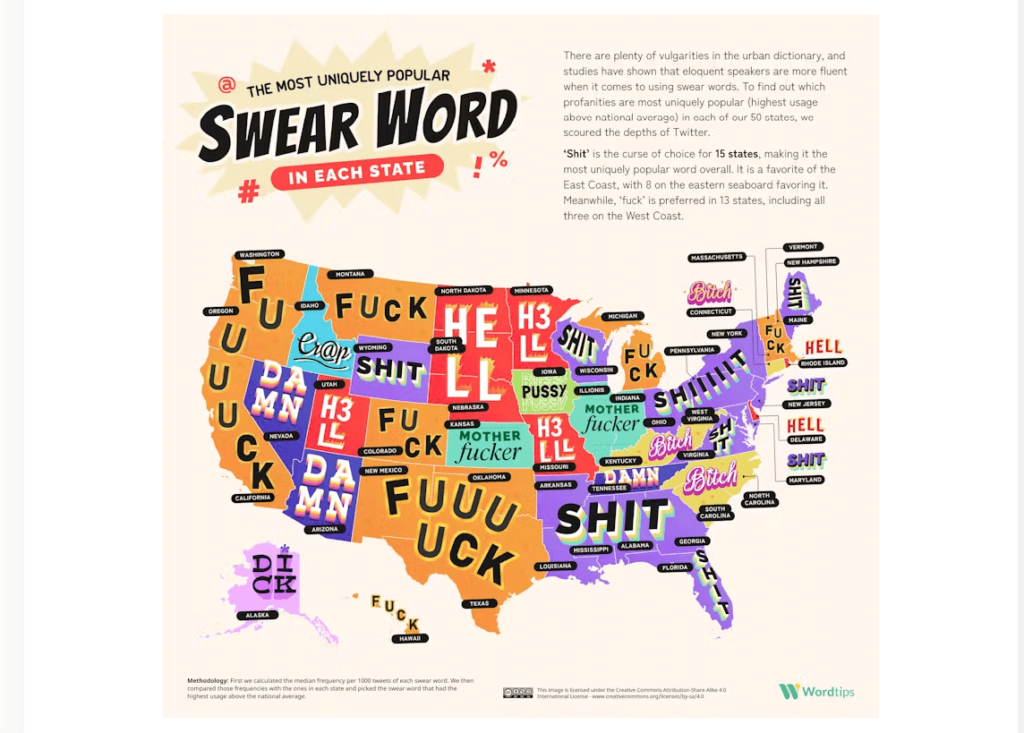
Each state becomes an interesting data point for a journalist to share.
Results: They ended up with almost 300 LRD, with coverage from local pubs in Alabama, Louisiana, and NY and more general coverage from publishers like Mental Floss.
So far, these studies have creatively presented data, but their methodology has been a little less data-heavy. Let’s look at a more traditional “index” or “city study” in the next piece.
20. CoworkingCafe’s America’s Top Cities for Work/Life Balance & Mental Health
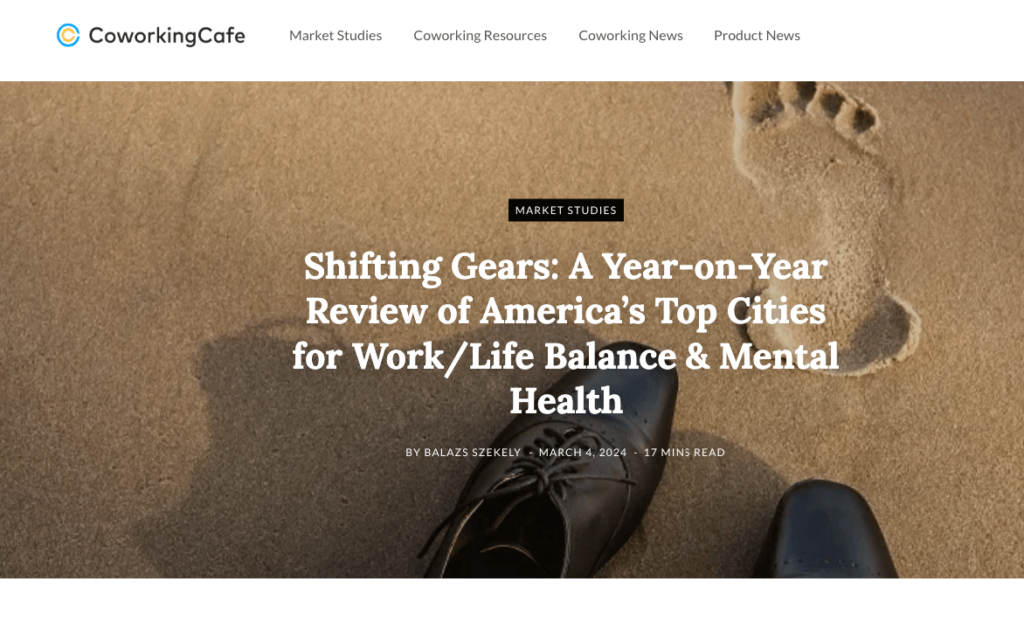
Strategy: Creating a piece for regional city coverage.
I’m writing this piece during Mental Health Awareness Month in May. So it’s fitting to share Coworking Cafe’s study about the top cities for work/life balance and mental health.
To create this list, they needed to conduct an extensive data study and determine which factors best represent “mental health and work/life balance.”
So, they focused on U.S. cities with at least 200,000 residents and scored their piece based on factors like average work hours per week, green spaces, and recreational amenities (among others).
Then, they scored the cities to create the index below:
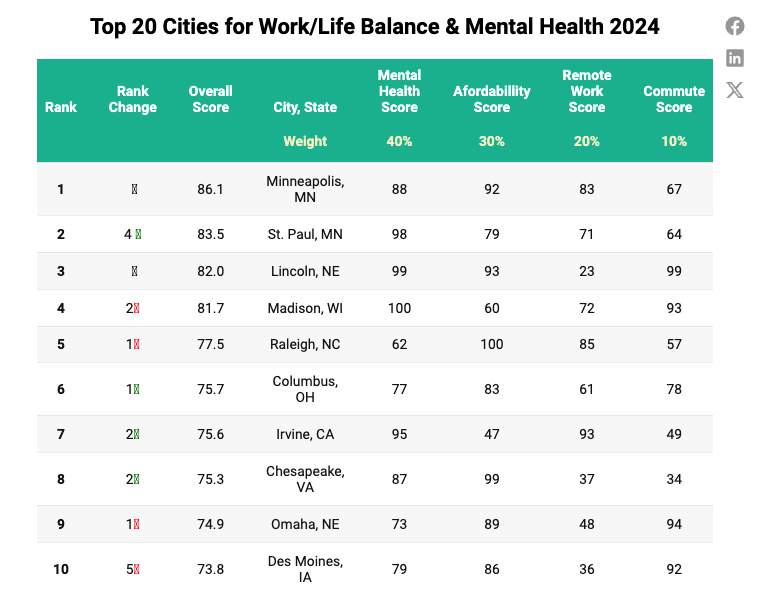
Each category gets weighted differently, and each city is scored accordingly.
How to pitch: With the information broken down and scored, they can contact local publications for the top-ranking (or sometimes bottom-ranking if it’s newsworthy) cities.
You can even lean into city “rivalry,” as I explained in a recent newsletter.
Results: They gained over 75 LRD, and their coverage came from many local publications. They also received links from colleges and universities in the cities that ranked highly on the list, which is a great alternate angle for these indexes.
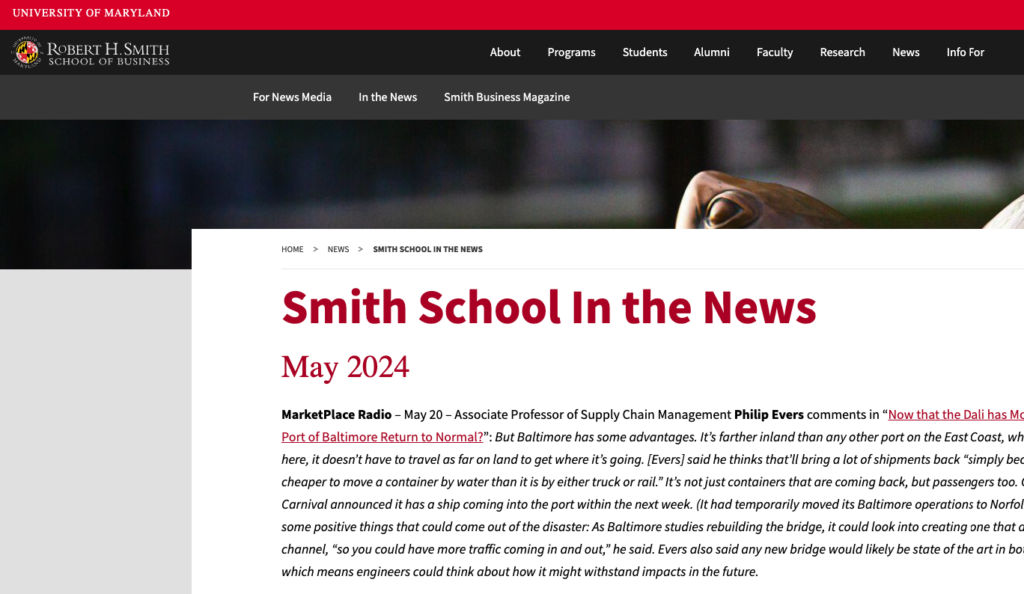
Let’s step away from data and get into digital PR examples with interactive elements.
Interactives
Interactive content is typically high effort but can have high rewards. Most require developers and designers. However, with AI these days, you can code pretty much anything.
(Check out how UK agency Distinctly is working on building a digital PR campaign using only ChatGPT.)
With that in mind, let’s look at some interactive pieces in various industries.
21. JustPark’s Reaction Time Test
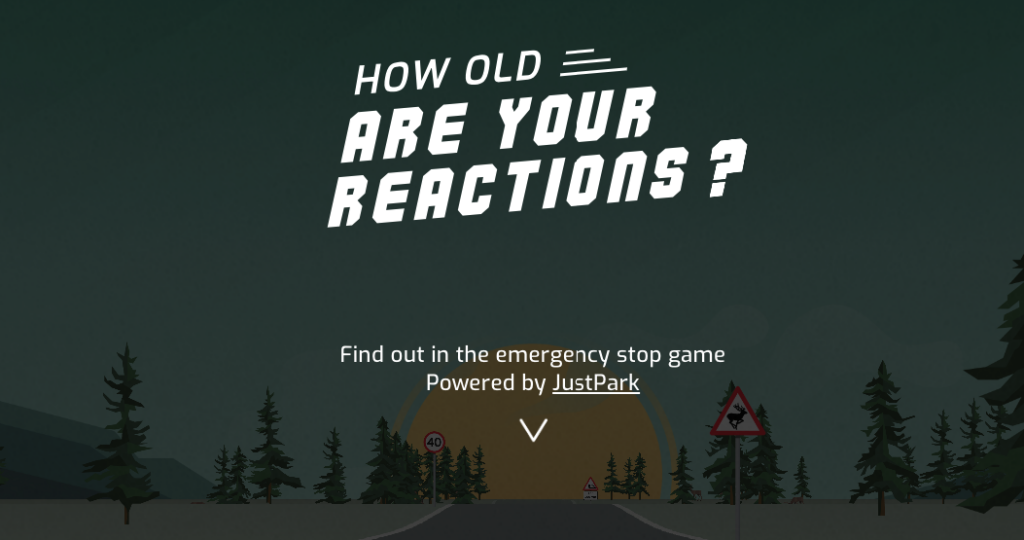
Strategy: Creating an interactive game.
JustPark is a UK parking app that lets users reserve or rent out parking spaces. So, they could focus their content on driving.
They created an interactive game that simulates driving and gauges your reaction time.
Then, your results are compared to those of the typical age.
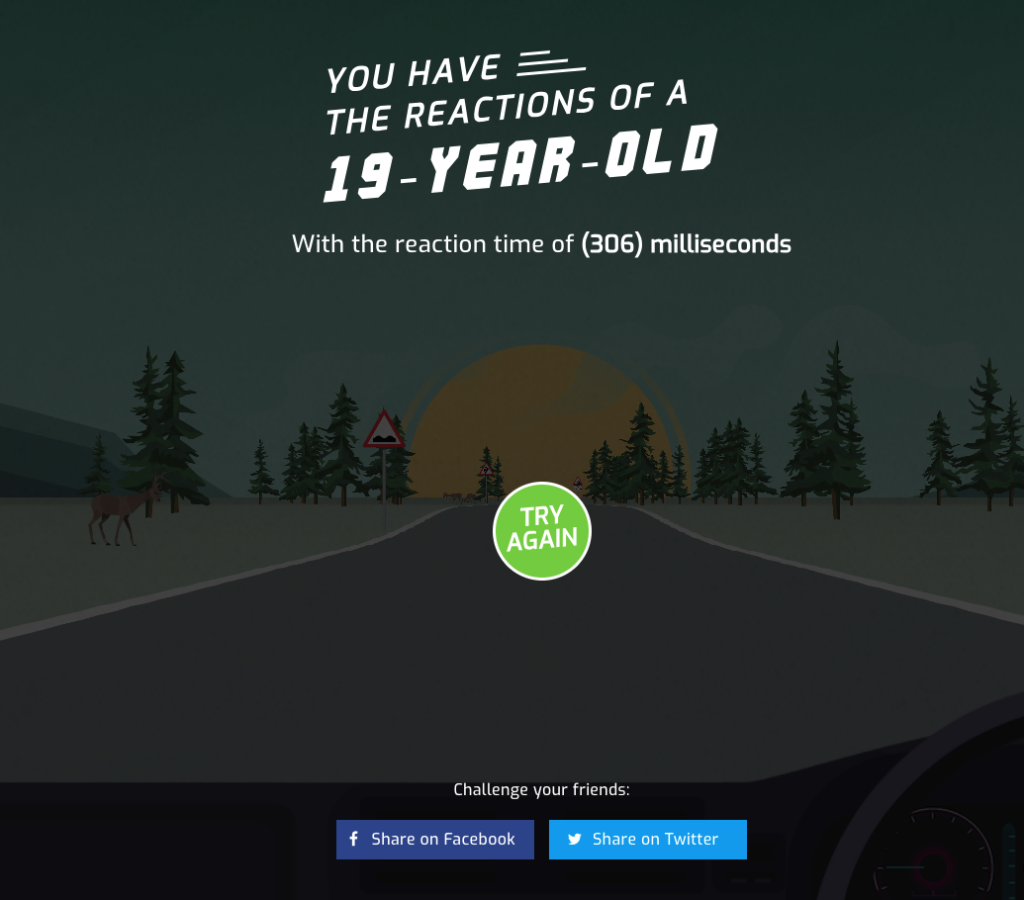
Games like these are great for building links because they have built-in sharing triggers.
For example, when I got my score, I immediately wanted to brag about it to my friends. (I may be 37, but I still have the reaction time of a spry young buck!)
How to pitch: Since this appeals to drivers, there is obviously a built-in outreach market there. But they cleverly positioned this as a reaction test, not a “driver test.” So, this appeals to the mass media outlets as well.
Interactives can sometimes be challenging to pitch, so I’ve seen some PRs that include animated GIFs or at least screenshots.
Results: This interactive digital PR campaign got them over 1,300 LRDs, including many UK-specific outlets like DailyMail and Metro. They were also featured in many international sites like Larepublica and Levif.
22. Zava’s Sexual Exposure Calculator
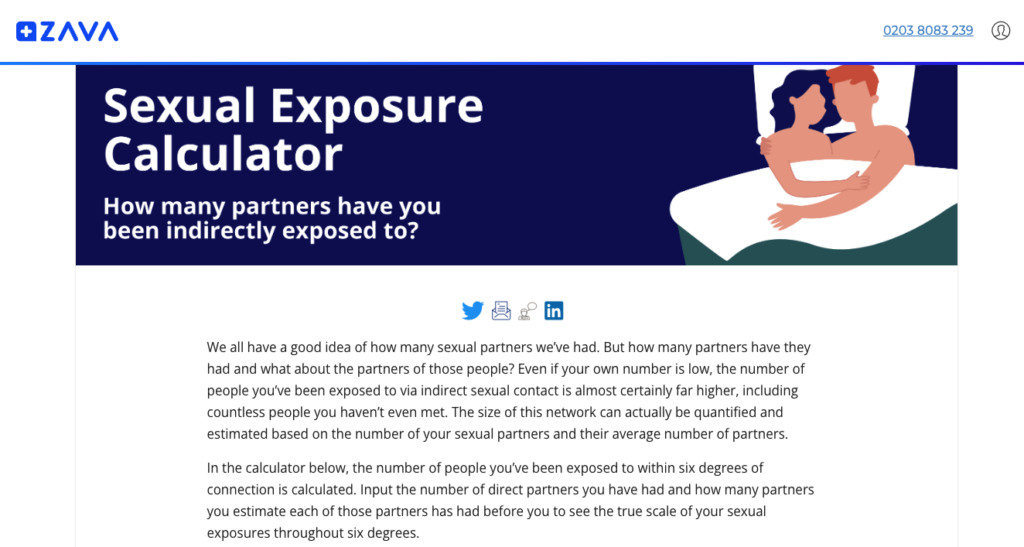
Strategy: Creating an interactive calculator.
I talked about calculators as a tool for tackling search-driven keywords, but they can also be pure link bait as well.
Zava is a prescription medicine site in the UK and Europe that offers solutions for STDs, ED, and other things that most don’t like to talk about.
So, Zava smartly leaned into this and created their sexual exposure calculator. This is not only a helpful tool that provides real information but is also highly linkable, given the subject matter.
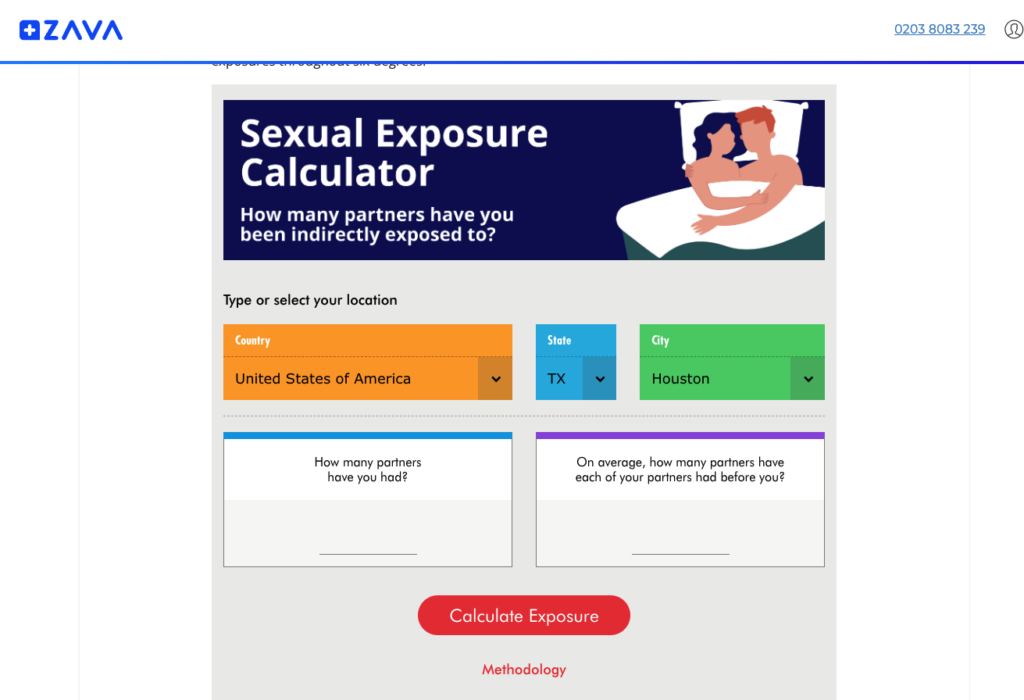
How to pitch: Although people might not love discussing it, many news publications do. So, this is pitchable to a variety of general news pubs as well as getting into wellness sites.
Results: It currently has 45 LRD, including coverage from Express, Metro, Esquire, and, surprisingly, even PCMag.
Microsites
Sometimes, brands create an asset so significant that it ends up on a microsite. This is done less often as the link value may not be passed on as clearly as if it were done on the same domain.
An example of this might be Lucidworks’ The Data That Lies Beneath.
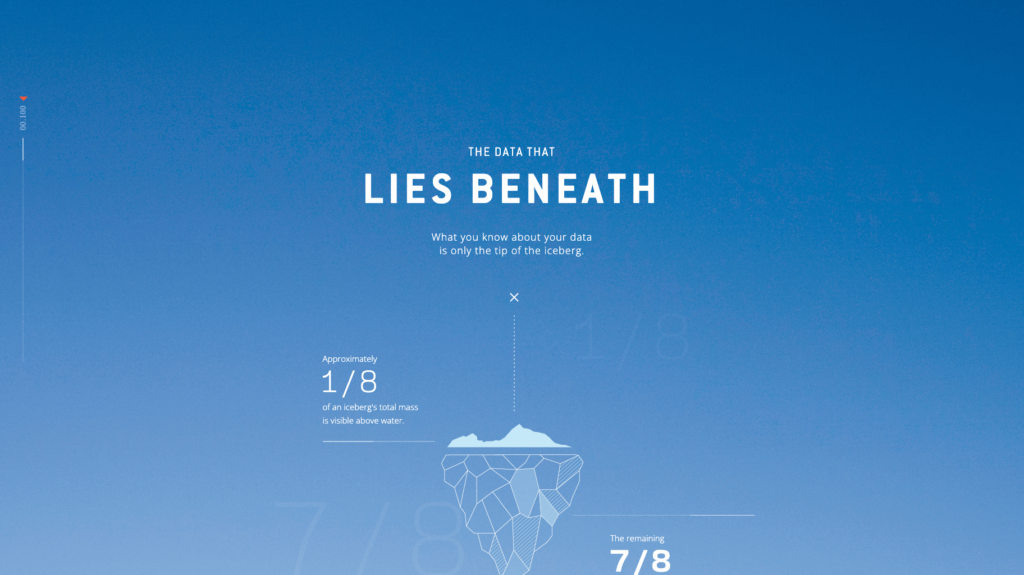
For digital PR, you are better off building your content on your site for the link value. A microsite can still work if you are building it just for awareness.
I’ll show you a unique version of that in the next section.
Newsjacking
You can news jack with any of the previous kinds of content mentioned. It can be a data study, an interactive, or sometimes just a simple quote.
The challenge is that you have to move quickly actually to ride the news wave.
Brian Dean discussed using his tool Exploding Topics to catch trends that are on the rise but have yet to reach their peak.
But to catch something in the news currently, you need to be plugged into the news.
Here’s one example that went above and beyond:
23. HireAHelper’s WeWontMoveYouChargers
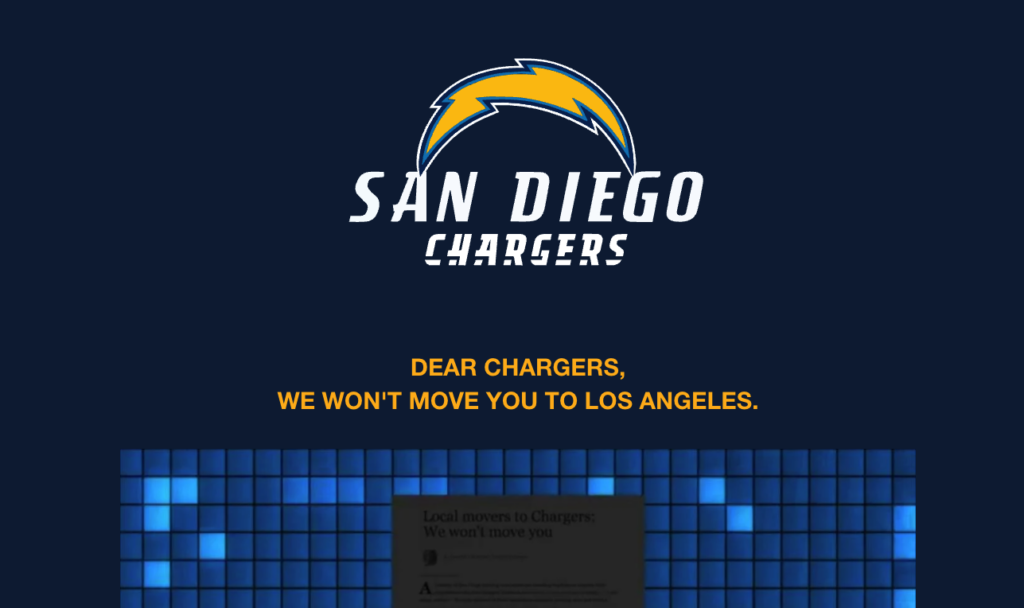
Strategy: Newsjacking a bit of regional news with pitchable content.
I’ll set the scene. The San Diego Chargers were an American Football team leaving San Diego and moving to Los Angeles to become the Los Angeles Chargers.
The San Diego fans were not happy.
So, the San Diego moving company HireAHelper had a very creative idea. They created a microsite called wewontmoveyouchargers.com to boycott the move.
They then enlisted several other moving companies in the SD area and pitched this project to local media.
How to pitch: Pitching a newsjacking piece involves reaching out to the same journalists who covered the original news topic, which would be journalists in San Diego and LA.
However, after this piece gains traction, it could be pitched to more general news. But don’t take my word for it; check out Ryan Charles’ breakdown.
Results: This piece of content not only received 45 LRD for the microsite from top-tier news outlets like Fox, CBS, CNN, and USA Today, but HireAHelper, who spearheaded the post, also received a lot of love, including multiple TV spots.

But you don’t always need a microsite for newsjacking. It’s quite a rare feat, given how much lift it can take in such a short time.
24. RareCarat Jewelry Estimates
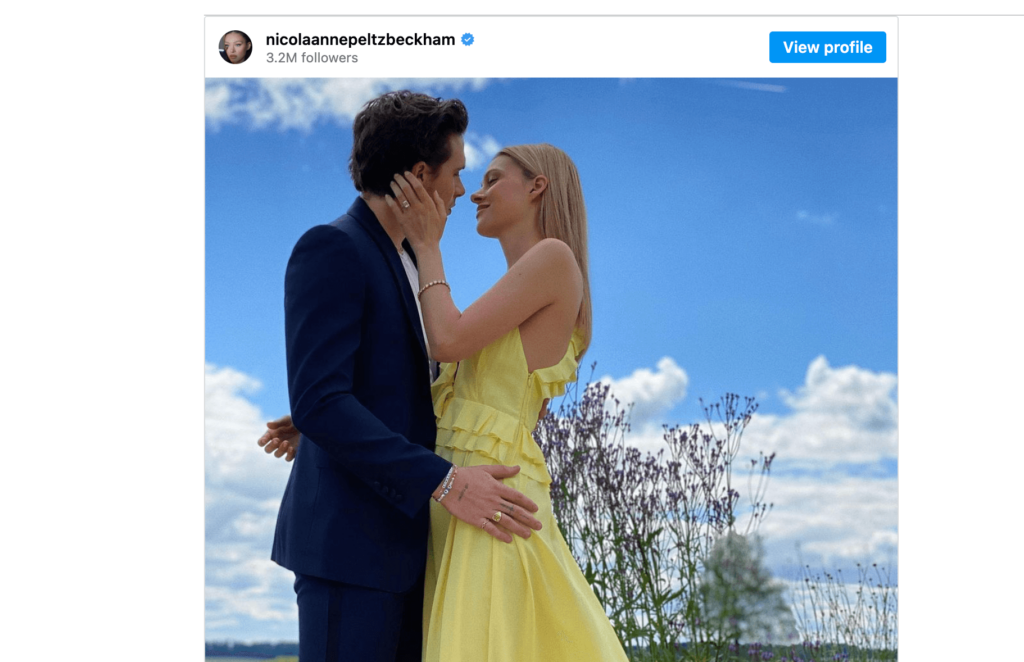
Strategy: Newsjacking a bit of regional news with a quote.
If you have something important to add to a story, you can try to get a link to it. Unique data and insight can provide extra context for a news story and make you an invaluable resource to a journalist.
For example, Brooklyn Beckham’s engagement was one of the significant news events in the UK in 2020 (besides that thing we don’t like to talk about).
How to pitch: You must be prepared to add value to a trending news topic. You need to have something relevant to say and be an authority in the space.
In our podcast episode with Mark Rofe, he mentions, “I think the answer would probably be, would you feel okay if you got invited on TV, like live TV, to kind of talk about that?” I think that’s the best way to approach newsjacking.
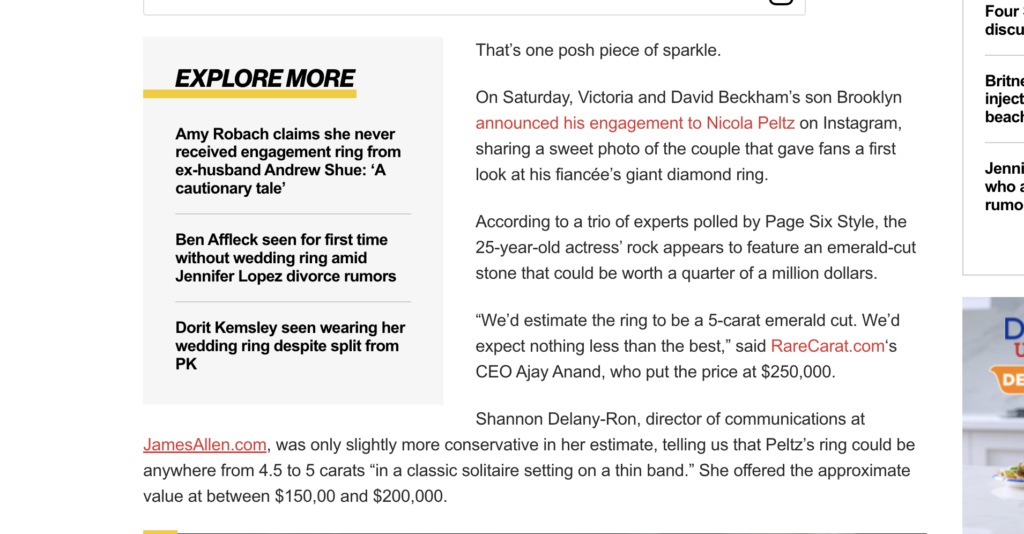
Results: Jewelry site RareCarat’s CEO Ajay Anand got a quote and, importantly, a link from PageSix by providing their ring estimate.
Talking with Digital PR agency RiseAtSeven’s team, they used this strategy to tackle multiple celebrity engagements and pitch their client for over 100 placements over multiple months.
Where to Find Digital PR Examples
If you’re stuck in an idea rut or looking to jumpstart your brainstorming, here are some great places to find your own digital PR examples:
Content Newsletters and Roundups
Many others out there collect great examples and showcase work from around the web, either as an email, a PR newsletter, online roundup posts, or even on dedicated X accounts.
Iona Townsley’s Grapevine Newsletter
A monthly newsletter showcasing fantastic digital PR campaigns from around the web.
Thea Lauren Chippendale’s The PR Insider
This weekly newsletter includes PR campaigns and resources for those looking to up their game.
We highlight case studies from BuzzStream users’ digital PR campaigns at least monthly.
Nathan Yau’s FlowingData Newsletter
A weekly newsletter sharing really cool data visualization work from around the web.
@Digitalprex on X
This account on X shares PR content found online.
A Google search for “digital PR case studies” from digital PR agencies will get you far.
Content Inspiration from Creators
Content inspiration can come from anywhere. We have an entire post on the topic, but here are some of my favorite places to get inspired.
Neal Agarwal does some great interactive work. (If you want to kill some time, check out the Password game.)
Remember StumbleUpon – it’s back! In CloudHiker form!
CloudHiker takes you to random sites on the web based on the topics and industries of your choosing.
Reddit’ r/dataisbeautiful and r/infographics
Reddit is a treasure trove of great content from around the web. Its search functionality can also help you find nuggets of gold like this thread.
Content Inspiration from Publications
I mentioned in the beginning that I didn’t want to include examples from these types of sites because they aren’t the kinds that individual sites typically release, but they are still incredible for inspiration.
The graphics team at NYTimes is masterful.
So is WSJ’s team.
Same with Reuters.
And Bloomberg.
I’m saving the best for last. Pudding.cool is one of the most creative agencies that tell stories with data.
Did I miss anything? Reach out and let me know!

 End-to-end outreach workflow
End-to-end outreach workflow



 Check out the BuzzStream Podcast
Check out the BuzzStream Podcast



